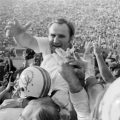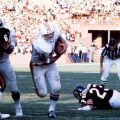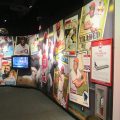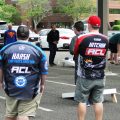JerseyMan
“It’s Neil Time” – Neil Peart 1952-2020
After the passing of the greatest rock drummer that ever lived, JerseyMan allowed me to write a one-page tribute for the Spring 2020 issue. Click here to see the PDF from that issue.
I don’t know whether the middle-aged fellow next to me was as devoted a Rush fan as I was, but he’d clearly been to a show or two.
It was 2007. The musical heroes from the Great White North were on the stage in Camden, blasting through “Malignant Narcissism”, an instrumental from their latest album Snakes & Arrows.
As rock music’s most virtuoso rhythm section took turns filling spaces on the bass guitar and drum kit, my neighbor turned to me, his face lighting up, and knowingly informed me:
“It’s Neil Time.”
I knew he was right. When Rush played a funky instrumental in the last third of a show, the next item on the menu would be an utterly mind-blowing exhibit of percussion.
Geddy Lee may be the best bass guitar player of his generation. Alex Lifeson could shred on a guitar with the best of them. Yet even sharing a stage with two rock music heavyweights, the Rush concert was about Neil Peart.
He was the one driving the music, measuring the pulse of it, bringing it with the most solid backbone his bandmates could ask for, regardless of the complexity of the time signature, despite constantly tearing into manically furious fills. Throughout the show, “The Professor” would execute ridiculously complicated drum parts to absolute microscopic perfection, so accurately that hundreds of air drummers in the audience could mimic his every move. Until the instrumental concluded and the stage became his.
To witness a Neil Peart drum solo was to experience a moment of disbelief in human existence. He was blindingly fast, playing crossovers so quickly that you worried he might chop a limb off. He was technically brilliant, with unparalleled limb independence, thumping a steady waltz with his feet as his wrists rattled the kit in a completely different time zone. The solo even became musical…he would tap on a marimba, incorporate horn samples punctuated with blasting fills, and then conclude the percussive masterpiece providing the backup to a Buddy Rich classic.
After it was over, in the wildly appreciative audience, you would both hear individual voices mouthing four letter words, incapable of rational expression, and see heads shaking in total bewilderment.
John Bonham and Keith Moon were legendary drummers, worthy of any discussion of rock music’s greats. They were both true originals. But their legacies received an assist from the biggest legend booster in music, the untimely death. Both of them perished at just 32.
Neil Peart lived 67 years, not long enough to clear the average for a human, but long enough to produce plenty of evidence, in recorded music and live shows, that he was the G.O.A.T. Argue the point if you want, but before you attempt such a foolish endeavor, try watching “La Villa Strangiato – Drum Camera” on YouTube first.
And know there’s plenty more where that came from. If I’m carrying a phone with me, I don’t even need to speak to win the argument.
I will forever be grateful for the 23 Rush shows I saw, and the life-affirming highlight that was Neil Time. A Neil Peart drum solo alone was worth twice the price of a Rush ticket.
R.I.P. Professor.

Northlandz Miniature Wonderland Railroad Museum

Sometimes JerseyMan lets me come up with my own assignments, so I got to visit Northlandz in Flemington, NJ … the Model Train Capital of the World! This article appeared in the Spring 2020 issue of JerseyMan; click here to see the PDF.

Kind of like the railroad version of the I-295/I-76/I-676/NJ-42 interchange.
All Aboard!
The Northlandz Railroad Museum in Flemington was listed in the Guinness Book of World Records as the world’s largest model railroad. Bruce Williams Zaccagnino’s creation is now the beneficiary of new ownership, an expensive makeover, and finally, the marketing respect it richly deserves.
Julie Parker’s occupation was to tell people about businesses worth visiting in Flemington.
And she had never heard of Northlandz.
That’s roughly the equivalent of being in charge of Philadelphia tourism, and not being aware of Independence Hall, the Liberty Bell, the Art Museum, and the Reading Terminal Market.
It wasn’t Parker’s fault, though. The genius behind Northlandz is an excessively modest man, who cared more about creating his art than promoting it.
She fondly remembers meeting him.
“I was doing the Flemington Information Center. Somebody told me, you’ve got to go see Bruce Williams, he just opened this place called Northlandz. I said, okay, maybe I can promote him. I had a group of businesses that would pay me and I would promote them all over Flemington.
“He actually had me go through it, and I came out and I looked at him and I said, ‘Oh my God, you built this whole place yourself?’”

This is about 1/100th of Northlandz.
If that story is remarkable, it gets better. This phenomenal exhibit of a hobby taken to an unimaginable extreme was almost decimated.
Thankfully, the building fell into the right hands…businessmen with more enthusiasm for putting smiles on faces than for profit.
Tariq Sohail, one of the new owners, was equally shocked and amazed in his first visit to Northlandz. He was minding his own business looking for a storage warehouse, and came upon a large gray building off Route 202 that might work.
“We drove past it so many times. I never knew what it was. Our real estate guy said, if you don’t like what’s inside, you can always demolish it.”
As Sohail describes his reaction to seeing what was inside, Parker chuckles, as if fully appreciating the astonishment factor.
“We started going through the whole tour,” Sohail continues. “We were like, in our lifetime, nobody has ever built something like this. We’ve traveled throughout the world, we’ve never seen anything like this.
“So we decided to take a risk and invest into it and promote it.”
That they’ve done. Northlandz needed work, to be sure…read reviews from a few years ago and you’ll see a lot about the state of disrepair it was in. Sohail and his partners have thus far poured several hundred thousand dollars into cleaning it up, and the results are nothing short of remarkable.
“There are people that came three or four years ago and they say, we can’t believe the difference,” Parker says proudly.
The new ownership has a larger vision for Northlandz too…it includes shuttle buses from New York City, a hotel, a banquet hall, and much more. All revolving around a toy train set.
That said, it is one truly amazeballs train set.

People like to live dangerously here.
Northlandz is, simply put for brevity, the world’s largest model railroad, according to the Guinness folks who are experts on such things. It spans over 45,000 square feet and 16 acres. The walkway just to go through it is over a mile.
To give you an idea of just how staggering its size, this observer had taken over a hundred pictures before reaching a sign that reads: “You are now 25% through Northlandz”.
Every moment is sheer model railroad wonderment. Huge displays filled with mountains and bridges, offering backdrops to bucolic still life of homes, factories, rivers, and neighborhoods. There’s “Iron Valley”, with its multiple iron bridges gracefully leading through mountain tunnels. There’s “Joycetown”, with churches, homes, and model trucks decorated with staples of American commerce like Kodak, Dollar Tree and Valvoline. There’s a fully detailed city mockup featuring an aircraft carrier. And a display of mountain life with busy railroads throughout that literally occupies three floors of the building. Tunnels? Northlandz features over four hundred of them.
On and on and on.

Like a scene from The Fugitive, isn’t it?
Any one of these displays could be the highlight of nearly any museum in the country. You could literally spend hours in one spot, watching a toy locomotive charmingly meander through a perfectly scaled-down neighborhood.
And this marvel was nearly all built by just one person.
Sohail estimates that Zaccagnino spent 17-19 hours daily, seven days a week, for close to four years building a miniature world. As one can imagine, he received little to no support from family members…as if spending eight hours a day and five days a week in a cubicle somehow makes more sense. According to Sohail, only Bruce’s wife Jean always supported the venture.
You could probably be forgiven for thinking your neighbor was crazy for devoting even sleeping hours to building a model railroad.
Then you see the finished work, and you realize crazy people are awesome.
“You won’t believe your eyes” is Northlandz’s slogan, and despite seeing it every day…Parker is currently the Northlandz Marketing and PR Director…she repeats those words herself often, with genuine passion that every employee shares.
“I just feel it’s magical,” she gushes. “How can somebody have conceived this? It’s incredible. You go through it and you start seeing all these little trains going in the little villages and the different themes and the different venues.”
“Everything is built by hand,” Sohail adds. “He told us one of the bridges that he built is 40 foot long, 23,000 small wood pieces, that he put together one by one by one by hand.”

Yes, I would go to church before crossing that bridge too…
Ask anyone working at Northlandz what the appeal of a huge model train set is and you’ll get a different answer.
Parker thinks it’s the glimpse of history.
“I think it goes back to the industrial revolution. Trains made our country great. They transported everything. Food, industry, it’s like the backbone of our economy. Buses, trains and cars, they’re what makes the economy tick.”
Sohail believes the appeal reaches us on multiple levels. He refers to young people who come to work at Northlandz and help with the layouts out of pure passion.
“Within the train layout, you have to have more than one skill. It’s architecture, it’s engineering, it’s electrical, it’s design, it’s scenery. Basically doing one hobby, you’re learning all different skills.”
Ken Vogel, a train technician, generously took time to point out multiple intricacies of Northlandz during this interview. He remembers his own days of building model trains, and bringing one of his fellow hobbyists to Northlandz for the first time.
“Bruce signed a box car that we brought here from my nephew. What I said to him at that time was, I know a lot of people that are remodelers who always wanted to build an empire and never did it. I said, you’re the only one that did.”

Who knew miniature life could be so much fun?
Sohail thinks the moving train gives life to a piece of art. “You’re looking at something beautiful going up and down, and all of a sudden the train comes.”
Worth putting over $300,000 into preserving? No question for Sohail. “Every time I come, it excites me as well, even when I own it. I see the people coming out of the place and I see how big the smiles on their faces and how happy they are to see it.
“That’s made me happy.”
Walking through the magical railroad empire that is Northlandz, one gets a sense of needing to be of advanced age to fully appreciate the endeavor. The longer you’ve spent on Planet Earth, the longer you’ve gone without witnessing anything like it.
But even this observer’s little ones can’t wait to go back.
Did this post make your day a little bit?
I hope so. If it did, I would really appreciate your support.
When you use this link to shop on Amazon, you’ll help subsidize this great website…at no extra charge to you.
Thanks very much…come back soon!

Isn’t “largest miniature railroad” like “light heavyweight”?
If You Go (And You Should)
If you are at least enough of a model train enthusiast to, say, put a little track under your Christmas tree each year, you have to visit Northlandz. In most any search for “largest model railroad in the world” or “largest model train display”, you will find Northlandz in the list.
The most important piece of advice for going is this: devote an entire day to your visit, whether you’re bringing the grandkids or not. You may be able to enjoy all of the exhibits in an hour, or you may want to take more time to fully appreciate the astonishing level of detail…and that can truly take a full afternoon.
There is a kids play area in the middle of the museum, which features an organ that Zaccagnino would play for visitors from time to time. Zaccagnino is retired now, but there is still enough to give the little ones a break before they see the rest of the museum.
You can find a few complaints online that Northlandz is on the pricey side, although it’s well worth every penny in this observer’s opinion. That said, there are online coupons to take a few bucks off of the price…just search for “Northlandz coupon”. Military, teachers and seniors get discounts, and persons with disabilities get in for free.
It’s easy to get to Northlandz in less than an hour or so from the Philly area, but should you need to spend the night, there is a Travel Inn & Suites just steps away down the road, and a Hampton Inn a bit further away in the heart of the shopping area of Flemington. The Hampton tends to get better reviews.
If you’re hungry there’s McDonald’s, Chick-Fil-A, and multiple other restaurants where U.S. 202 meets NJ-31 just a short drive away.
One last thing…if you take the kids, they’re going to want to go back. Not that you’ll mind.
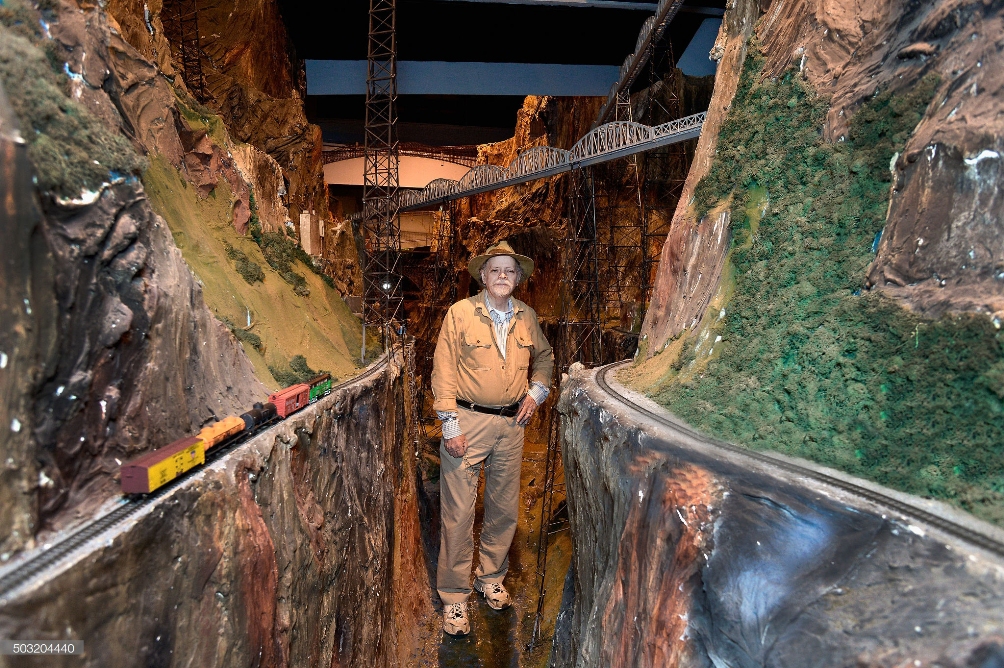
The genius behind it all. (Photo by Paul Marotta/Getty Images)
The Man Who Built It
Bruce Williams Zaccagnino got started in the same place most all model railroad enthusiasts do: in his basement. More correctly, in a basement of a house that was being constructed, according to the Northlandz website. The construction workers would leave for the day, and he would build mountains and tracks in his new basement.
Like today, nearly everyone who saw his work was quite impressed, to the point where he would open it for the public on weekends. He purchased the land on Route 202 as the popularity grew, and the rest is history.
Zaccagnino was no stranger to artistry, incidentally. He made a decent amount of money in the video game industry, including winning several awards as a developer/designer. He was, according to Sohail, quite the accomplished musician as well. “I watched him play the organs that we have over here. I never saw anybody play that well.”
But Northlandz was his passion, obviously. To the point where he spent his time building his dream, rather than marketing it. Sohail compliments his modesty, but expresses regret that his people didn’t meet him sooner.
“We would have promoted this throughout the world,” he says.
“He’s been interviewed with CNN and Fox, all the major, you know, and he never made a big deal out of that. He’s in the Guinness world records, this place, and he never even promoted that fact. We saw the certificate, it’s sitting on the exhibit and anybody could take it.”
“Bruce didn’t really advertise; he let itself advertise,” says Ken Vogel. “The point was, it was a guy who had a dream about building a great layout and actually pulled it off. The dream is accomplished.”
Zaccagnino is retired now…traveling, according to Julie Parker, so one guesses he’s actually riding trains instead of building them. But he’s appreciative that his art is going to live on.
“I think he was starting to see that a lot of stuff was falling apart,” Sohail reflects. “He had a feeling like if somebody doesn’t save it, it’s going to go away. When we bought it and we started repairing it and cleaning up and everything, he was very happy, you know, my art is being preserved.
“He said, this is my gift to the world.”

The Electric Road Trip

The technology keeps improving with electric cars, and it’s becoming much easier to take long trips without concern for being stranded. Yours truly explored and wrote about this for the Fall 2019 issue of JerseyMan magazine; you can view the PDF of the article here.
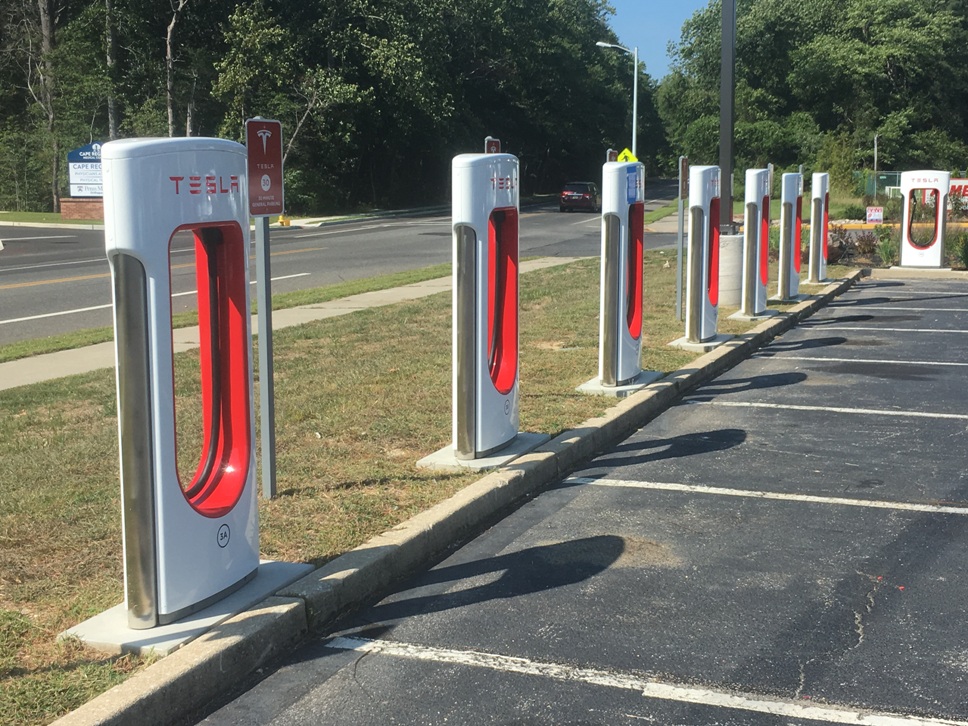
Plenty of juice available.
The Electric Road Trip
Car charging stations are springing up rapidly everywhere these days, making long-distance travel much easier for electric vehicle owners.
Sure, I want to save the planet from carbon emissions. Our children’s future depends on it. But is it really worth being stranded on I-95 on the way to Florida in my electric car?
Okay, maybe we’re not that spoiled. Despite some limitations compared to fuel-powered vehicles, electric vehicles are selling pretty well these days. We just need to solve that range problem.
As recently as 2016, McKinsey Industries, a firm dedicated to sustainability solutions, listed limited availability of charging stations as the third biggest barrier to electric vehicle sales, after the price of cars and limited driving range. Most EV owners still charge their cars at home, and owners of less expensive EVs with shorter ranges generally use them only for daily commutes and short trips.
But we are a nation of doers, and that situation is changing fast.
In May 2019, the Department of Energy reported that there are now more than 68,000 charging units in the U.S., nearly 11,000 of which are fast charging stations that can “fill up” an EV in less than 20 minutes. The Tesla superchargers appearing in many spots, including Wawas in the area, are only compatible with Tesla vehicles. But other networks are growing for the rest of us.
You may not have heard of EVgo, but you’ve probably seen the name NRG on the Broad Street Line’s Sports Complex station. Same company. EVgo offers DC fast charging…the fastest form available as of 2019…in 66 metropolitan markets from their considerable grid. As EVgo states, you can charge your car to 80% in approximately a half hour, while you stretch your legs, grab a bite, and take care of other business.
With new apps like PlugShare and ChargeHub available to route you to the next charging station, your biggest challenge on long road trips now is not spilling coffee on your phone.
Bill Evans, the CEO at Liberty Fox Technologies and one of our esteemed Legacy Club members, is the proud owner of a Tesla Model S.
The Model S isn’t cheap…it currently carries a price tag of $75K. If you’re a tightwad, you can drive a Model 3 off the lot for under $40K. If it helps, remember you’re going to be saving a lot of money in fuel over the long haul, even without the free supercharging for life offered to Model S owners.
Evans likes a lot of things about his Model S, but he considers the fuel savings to be “a nice perk”.
“I tend to drive between 1,800 and 2,000 miles per month. In my previous vehicle, I was averaging about $250 a month in gas. For the same mileage, I am averaging $80 per month in electric. So I am using about 1/3 the cost in electricity as I was in gasoline.”
The cost savings is generally typical of EVs. A Chevy Bolt currently averages 25.21 kWh (kilowatt hours) per 100 miles. So at 13 cents per kWh (the national average, according to the U.S. Department of Energy), then 100 miles would cost about $3.25. Even for the most fuel-efficient cars, that soundly beats gas prices.
But if you’re considering buying an electric vehicle to save money, we’re not quite there…yet.
In July 2019, U.S. News & World Report listed the cheapest electric vehicle as the Smart EQ Fortwo, at nearly $27K. The Fortwo is aptly named…attempting to shoehorn three people into one of these might make for a humorous YouTube video. Second is the Nissan Leaf at just under $30K, which is more spacious and offers 150 miles of range on a charge. Good for daily commutes…for longer road trips, maybe not so much.
But compared to the limited range technology of not very long ago, this is quite the improvement, and Tesla CEO and extreme visionary Elon Musk has stated that one of his company’s goals is making electric vehicles available at prices the 99% can afford. Given their great strides of late, this seems much more attainable than, say, colonizing Mars. (Which is also on Musk’s to-do list).

While you’re waiting, give your Tesla manual a read!
While the convenience and cost of owning an electric vehicle continues to rapidly improve, longer trips still require more planning. It’s not terribly difficult, but it requires more than simply pulling off the road at a Wawa.
For one, it takes longer.
A Level 1 charge is the equivalent plugging your car into a 120V outlet in your home, and can handle your short commute within reason if you charge overnight. With a Level 2 charge in a 240V outlet, available at most charging stations or from an adapter for your home, it takes about 4-8 hours to fill up. A DC Fast Level 3 charge gets the job done in less than a half hour.
Evans describes charging his Tesla like this: “If you plug the Tesla into a regular 120-volt outlet like you’d plug in your television, the car could take up to three days to fully charge (which is absurd). If you use a higher voltage outlet, the car can fully charge in about 5 hours.
“But if you need the car to charge really fast, you can get a very powerful charge at the supercharging station in as little as 15 minutes…and Tesla is working to reduce this even further to about five minutes. At 15 minutes or less, I would say it is no less convenient than a conventional car.”
But it’s still not quite as fast as the gas pump, which is why Tesla has been smart enough to install Supercharger stations at gas station/convenience shops, including some Wawas, Royal Farms, and other stores in the area. It works great for the store owner…the charging EV owner can spend time in the store ordering a sandwich or coffee while they wait.
Another growing spot for chargers is an obvious one…hotels. As of this writing, Marriott offers Level 2 charging stations at 3,137 of their hotels, including the Courtyard on Presidential Boulevard in Philly. Something to consider when choosing where to sack out in South Carolina on your way to Disney.
One important caveat, though…plan your trip to avoid the isolated station on the busy highway if you can. That could be a busy place. It’s a problem that internal combustion engine cars had in their early days.
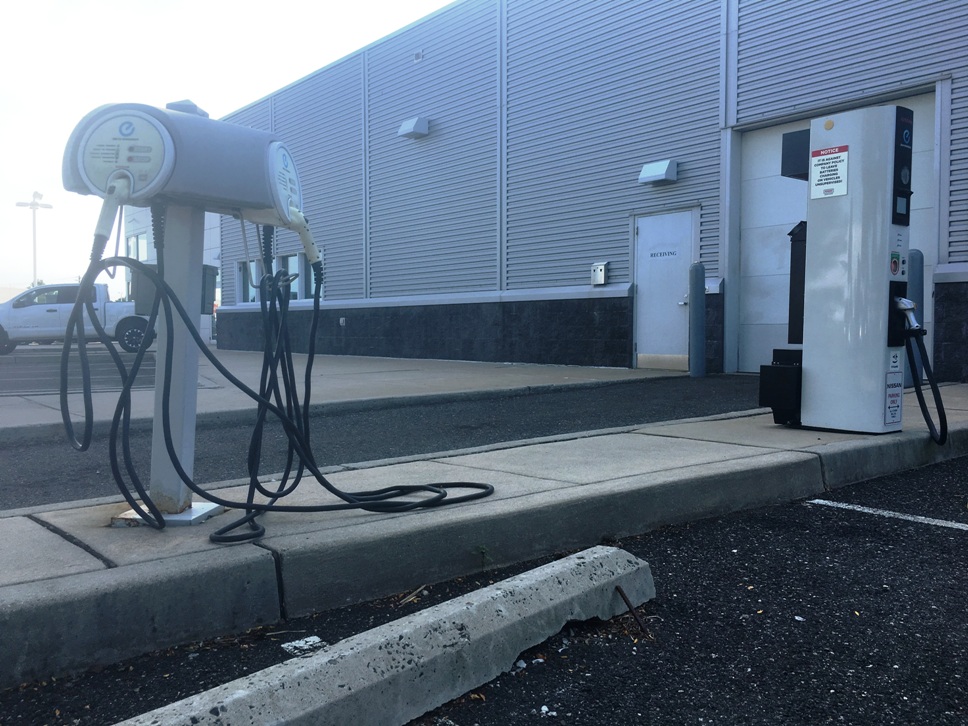
Car chargers at the Turnersville NJ Nissan dealership, where charging is free to customers.
With a rapidly expanding network of charging stations and dropping prices of electric vehicles, we may all be able to hit the road to visit a few ballparks without emissions in the not too distant future.
As recently as April 2017, Eric Schaal at Motor Biscuit published a piece called “5 Biggest Problems With Electric Vehicle Charging”. In it he explained that it’s more challenging to charge your electric car…especially while you’re already on the road…than it is to simply stop at a pump and fuel up.
“It’s quite difficult to fast-charge your car in many U.S. cities, even when money is no object.” Schaal pointed out. “You have to drive through strange neighborhoods and try to locate chargers in vast parking lots where GPS is known to drop out of service.”
The apps help, but not as much as they should, according to Schaal. “You might need two or three apps just to know where a charging station is, and once you get there you might not be able to use it because it’s operated by a provider with whom you haven’t opened an account.”
Just two years later, Bill Evans can testify that Tesla owners, at least, don’t need to be concerned about being stranded on the highway.
“You really, really need to be neglectful to put yourself in this position,” Evans explains. “If you charge the car every day like I do, you start every single day with your full mileage range (240 miles or 330 miles depending on your model). Given that I rarely ever drive 240+ miles in a single day, this is really a fringe case.
“Secondly, as long as you are using the GPS feature of your car, the Tesla is fully aware of its range, and if it is concerned you won’t reach your destination, it will route the most convenient Supercharging location into your directions to make sure you stop and top off before continuing.
“To end up on the side of the road with a dead Tesla and no chargers requires that you ignore every single warning and recommendation from the car to force that situation to occur.
“If you started in New Jersey and wanted to drive to Disney World, the Tesla will route multiple supercharging stops along the way and include the charging time at each in the projected Estimated Time of Arrival. As long as you use the GPS, the car will plan the entire drive and charging locations.”
And once there are charging stations at South of The Border, it’s likely the Northeast will be all in.
Did this post make your day a little bit?
I hope so. If it did, I would really appreciate your support.
When you use this link to shop on Amazon, you’ll help subsidize this great website…at no extra charge to you.
Thanks very much…come back soon!
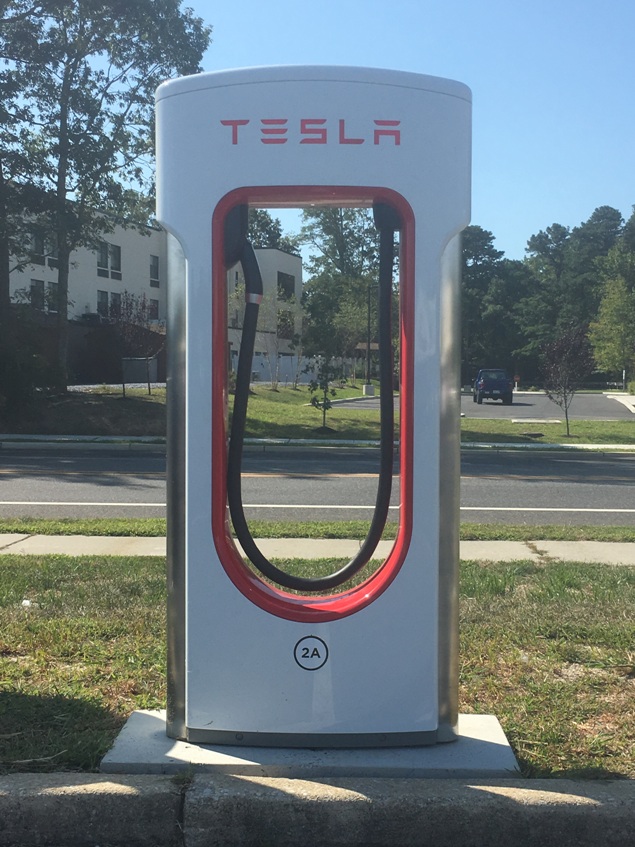
Stop waiting for the car to drain. It won’t help. Just do it.
Battery Myth No. 1 – Full Drainage
JerseyMan Magazine always goes the extra mile for its readers, so in addition to the useful information contained here, we can dispel a myth for you.
You’ve probably heard it before: let your smartphone drain completely before charging it up again. This will…supposedly…help your phone battery last longer. And it stands to reason people might find that useful with their electric car, too.
Here’s the real scoop from our friends at Mashable: “It’s better to charge your phone every day than to do a ‘deep charge’ from time to time. Lithium-ion batteries, like the kind used in Samsung and Apple products, fare better when they’re charged. If you constantly let them drain to 0%, they become unstable. Your battery has a finite number of charge cycles, and every time it fully dies, that’s another cycle out the window.”
Leaving aside that you would have to let your car idle for an extended period of time near a charging station, this applies to your electric vehicle’s battery…completely draining it can reduce its overall life too.
So there’s no need to time your car charging station visit to the kilowatt hour. Or wait for your phone to completely discharge, for that matter. A helpful tip at no extra charge!
Battery Myth No. 2 – The Colder, Longer Lasting Battery
In case you’re wondering, no, putting your EV battery in a freezer won’t make it last longer.
Like with gas-powered engines, EVs can suffer decreased performance and range in extreme cold weather. There are several reasons for this, including that the electricity running your car’s heater uses the same battery that is plowing a car through the snow.
But before you balk at buying a new Bolt out of concern for New Jersey’s sometimes biting winters, consider this: Norway…yes, Norway…is one of the world’s leaders in adopting the electric vehicle. Part of the reason is subsidies, but it’s hard to imagine Norwegians buying cars that don’t work in the cold.
Yes, there is definitely decreased range in electric vehicle batteries in below freezing temps, more so than in fuel-powered cars. But there are ways to overcome this, including “preconditioning”, or pre-heating your battery before it is finished charging, similar to remotely starting up your car before driving. Many EV models have this capability.
John Voelcker from the Green Car Reports blog also suggests bundling up and leaving your coat and layers on in the car. While it may be cringe-worthy to pay upwards of $30K for a car that still requires wearing a coat to drive, Voelcker adds: “Don’t worry if you think you look like a dork; the real dork is the guy stranded on the side of the road because he ran out of juice.”
Incidentally, extreme heat can do a number on your battery too, since batteries contain fluid that evaporates in high temps. Even more so than with fueled cars, it’s recommended that drivers park in the shade or in garage whenever possible.
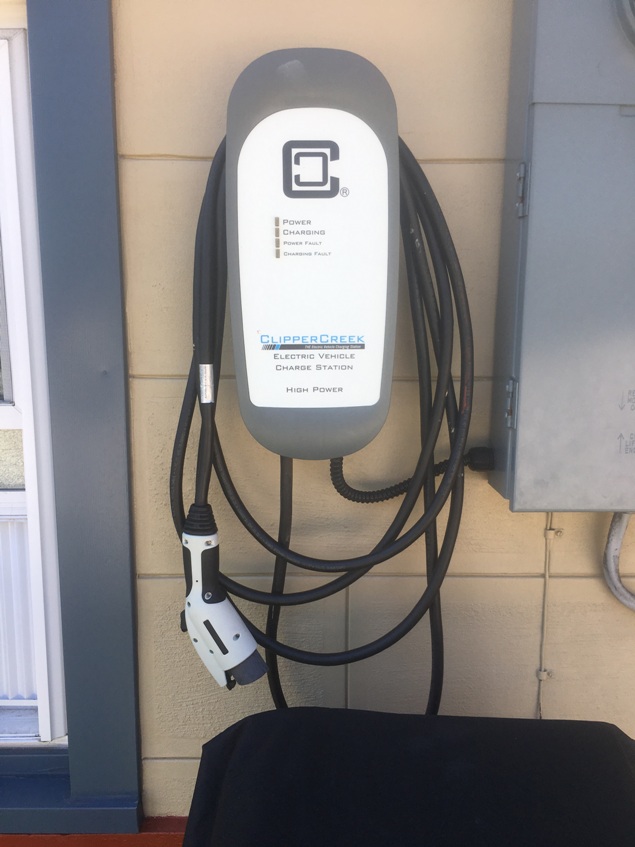
At the Candlelight B-n-B in North Wildwood, there’s only one charger. Don’t hog it.
Car Charging Station Etiquette
With charging stations still not quite as readily available at gas pumps, there is something of an unwritten code of conduct regarding their use.
One of the more common issues, according to Green Car Reports, is called “ICE-ing”. It’s when a car with an internal combustion engine parks in a spot with a charging station reserved for electric cars. If you can’t page security in the garage, the most you can do is leave a note for the driver.
Green Car Reports recommends other guidelines for using charging stations. For one, don’t occupy the space longer than you need to for a recharge, even if it’s a parking spot. If you can’t get to your car to remove the plug, you can leave a note for other drivers that they can remove it if they see your car is fully charged.
Also, if you can make it home, leave the charging station for someone else. They could be down to their last few miles and need the charge more than you do.
With their Supercharging stations, Tesla is somewhat enforcing charging station etiquette with an “idle fee”. If you keep your car at a busy charging station more than five minutes after your car is charged, a fee is charged on your account. Tesla states that this isn’t intended for profit…it’s working towards the goal of keeping charging stations as available as possible.
Basically it comes down to treating a charging station the same as a gas pump and not leaving your car there…but more so for now, at least until we go full electric.

Philly Forever – Former Eagles GM Jim Murray
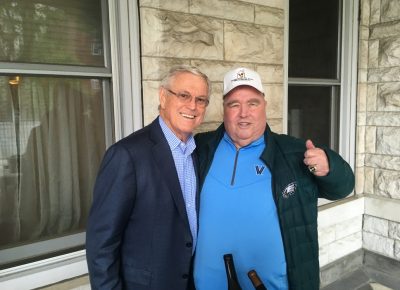
JerseyMan sent me to interview former Eagles GM Jim Murray for their Summer 2017 issue. You may remember that he hired Dick Vermeil, but you may not know about the larger impact he’s had…on families worldwide. (I met with Dick Vermeil at a JerseyMan event, and he told me he enjoyed the article, which made me happy.)

Philly Forever
Jim Murray was the Eagles GM who persuaded Dick Vermeil to come to town and lead the Eagles to a Super Bowl, but the born and raised Philadelphian’s impact still today reaches much farther than a football field.
Nearly half a century after an incident involving Santa Claus and snowballs at an Eagles game…you may have read about it…the City of Brotherly Love still today has a reputation for hideous monsters posing as sports fans.
One can imagine how, just eight years after that incident, it was enough to give a champion college football coach pause before taking a head coaching job in Philly.
Fortunately for all of us, Jim Murray, the Eagles’ general manager at the time, is prone to occasional moments of prescience.
“Vermeil’s very intense, very thorough. I remember inviting him to the Beverly Hills hotel, he answered the phone and hung up, thanks but no thanks. And then the phone rang ten minutes later and it was him.
“During the interview, he stopped and said, Jimmy, can I ask you a question? I said sure, that’s why I’m here. ‘Why would I come to Philadelphia?’ I said, what does that mean? He said, well I’ve been there, I was the special teams coach for George Allen and the Rams, those fans!
“I said Coach, I’m gonna be Jeremiah. I’m gonna be the prophet. I’m gonna tell you something.
“You come to Philadelphia and we hire you, and these three things will happen. Not only will you move to Philadelphia, you’ll bring your family, and you’ll stay there the rest of your life. You’ll never leave, and you’ll become a household word, no matter what else you do in your life.”
One could argue Vermeil has wanted to prove Murray right ever since, but it would have been a pretty big commitment if he didn’t like the area a little bit.
“Hiring the coach…that was the moment. You’re all in. If you hire the wrong guy, game over. People really, really care. The sports guys know that. Sports can change your life.
“And he is Philly. When he won the Super Bowl in St. Louis, Blue Cross had a big billboard. They didn’t even have his name on it. They just had him, congratulations on winning the Super Bowl. He became Philly.”

Dick Vermeil and Jim Murray, two great representatives of Philadelphia.
(photo courtesy of Jim Murray.)
Jim Murray will tell you that he was probably the youngest GM in the NFL whose father didn’t own the team. He was a sports information director at Villanova when he was told about an opening as a publicist for the Eagles.
Murray was happy at Villanova…he claimed to be the richest guy in the world despite a vow of poverty…but applied halfheartedly for the position at the Eagles anyway. He got the job. Five years later, Leonard Tose fired GM Pete Retzlaff and promoted Murray. “I wasn’t afraid to look Leonard in the eye and tell him what I thought about anything, and he hired me to be the GM.”
It turned out to be a wise choice…Murray found the right words to persuade Vermeil, after all…but Murray was also a great organizer, and thanks partly to him, a house at 4032 Spruce Street received a makeover and became a place where emotionally drained parents of sick children could rest. Today there 365 Ronald McDonald Houses in 42 countries.
That all started when former Eagle Fred Hill asked his neighbor Stan Lane to organize a fundraiser to help Hill’s daughter, who had been diagnosed with leukemia.
“Eagles Fly For Leukemia’s first event was this big dinner. Stan put on a bash, really good stuff. Leonard says, get Murray over here. He said, check it out.
“I went to see Kim Hill’s doctor, the old St. Chris’s. He said there’s a woman, her name is Dr. Audrey Evans, she’s at the Children’s Hospital of Philadelphia.”
Dr. Evans didn’t know what a Philadelphia Eagle was…she didn’t even own a television…so Murray had to explain that the owner had money and wanted to help. The two met with Tose.
“She said, we need these rooms called life islands. We give kids chemo, radiation, they have to be in a sterile environment. And he’s going, all right, how much? She says $50,000. How many rooms? Two. That’s $100,000. But Leonard, he was all in. He said, how much for the whole floor? And she didn’t hesitate, she said $1 million. And he didn’t hesitate. He said, I’ll tell you what, the Eagles pledge a million dollars. Jimmy will raise it.
“Are you kidding me? I have no clue, oh, what the …!”
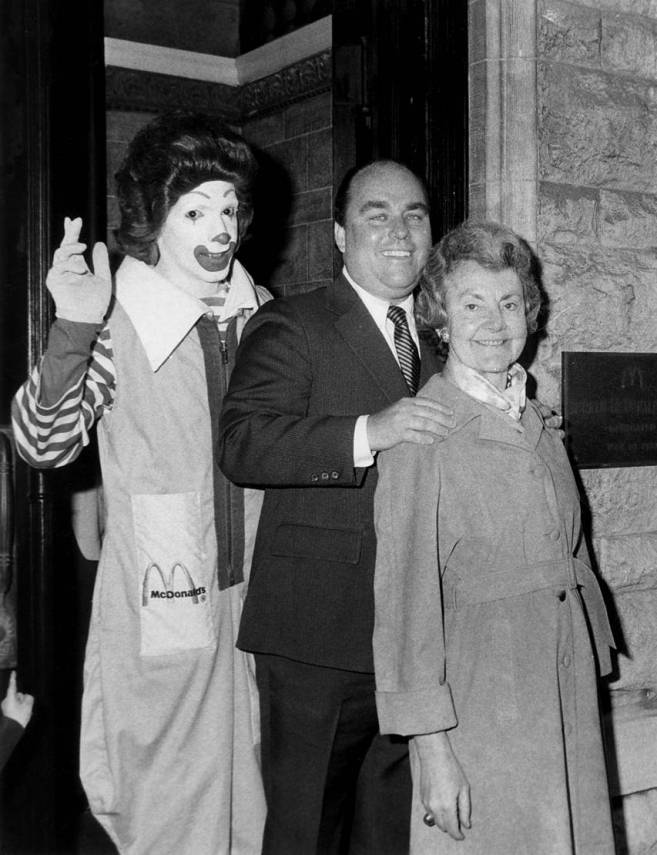
Murray with Dr. Aubrey Evans and the iconic mascot. (photo courtesy of Jim Murray.)
Murray’s first idea, a telephone fundraiser during a televised game against the 49ers, raised a grand total of $1,800. The Eagles did a bit better with a telethon following that, raising $125,000, which Murray presented to Dr. Evans at the blue line of the Spectrum.
“The most amazing thing was, I just wanted to get her off my back! And in the most beautiful words that only a woman can say, she says well that’s great! Do you know what else we need?
“I said, we’re in for a mil, here’s a buck and a quarter, what else do you need?
“That’s where the House was born. She said, do you know what happens when I tell a family their child has this disease? They don’t hear one more word I say. They come from all over the world to this hospital. If we could get a room at the YMCA, something like that.
“I said, no, no. This is Philly. We’re the old neighborhood, we’re poor. We took care of everybody. You need a house.”
Murray made phone calls to ad execs and McDonald’s regional managers, who offered donations from sales of the new green milkshakes and in turn asked for the House to be named after the new clown mascot.
“God’s hand was in that,” Murray says, “because naming it after Ronald, the kid’s not afraid to walk through the door. One freezing night I was waiting for a ride outside, Ronald’s statue is in the front yard, and this man pulls up from Tennessee. Seven kids, I didn’t even know which kid was sick. They all were like, he’s in there!
“I love that it’s a Philly story. I love that Ray Kroc, Frank Rizzo are all standing there, (former Eagle) John Canuso, his kids are there, renovated the second house. All these things…the planets lined up. You can’t put limits on God, prayer, or the power of sports for good.”
Murray frequently talks about life coming full circle. Eagles fans may remember the hiring of Dick Vermeil, the impossible story of Vince Papale, and the Super Bowl appearance during his tenure. When Murray reflects, though, it’s rarely if ever about victories on a football field. It’s the continued success of the Ronald McDonald House, the lives saved by Eagles Fly For Leukemia, and Vermeil hosting fundraisers with former players still talking about what Coach meant to them. Vermeil adopted Philly as his home; the man who predicted that he would knew exactly why.
He has too many stories to fit into a 1,300-word article…Murray is currently writing a book with “McMiracle” as a working title…but they all revolve around that theme. He never stops marveling at the impact of sports, and the kind toughness of the city where he grew up.
“I never get used to it. I could tell you story after story,” he reflects fondly. “You talk about sports, playing with pain, when you see what these families go through. To me, it’s the Rocky statue. It’s Vince Papale, it’s Invincible. You don’t forget your roots, you don’t forget where you grew up. I don’t think it’s complicated. I think we make it complicated.
“I have been lucky enough to be a little part of it. My book could never get finished. Most of the stories will never be written. And they won’t all be happy endings.
“But you know what? Everybody will be pulling for them.”
Photo credit: Ohio Redevelopment Projects – ODSA on Best Running / CC BY
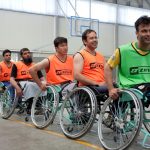
Wheelchair Basketball – Rolling Thunder

I had never known that wheelchair basketball was as established as it was, with professional leagues and established teams, until JerseyMan asked me to cover it for their December 2014 issue. I had the pleasure of interviewing John DeAngelo, a player for the Magee Spokesmen of Philly, who filled me in on the rough and tumble nature of the sport. You can view the PDF from the article here.

Rolling Thunder
Think wheelchair basketball is a small time, friendly competition? Think again.
At the Carousel House in Fairmount Park, the Magee Spokesmen are wheeling laps around the basketball court at the start of their weekly practice session.
After a few dozen circuits, they gather at one end. They begin start and stop drills, rolling out to the center of the court, stopping on a dime, executing hard 180-degree turns, and pushing back in the direction of the net.
Their coach, Eric Kreeb—who by day is a kitchen manager at Chickie’s and Pete’s—stands by and watches, smiling and shouting words of encouragement. Slide right, he shouts, turn and get on the line. The drills continue. Men push, turn, and then go from one end to the court to the other and then back…backwards. They pant, strain and sweat.
Back at the line, they’re huffing a bit now. “Turning left this time,” shouts Kreeb. His direction is met with some mild groans of protest. But the Spokesmen oblige, rolling out, turning left and rolling back. To some, it’s a competition. “Get your money!” one player shouts repeatedly. Forward and backward, turning wheelchairs left and right, drill after drill after drill. The practice is almost an hour old, and no one has yet touched a basketball.
Finally, they start shooting, taking turns at the foul line. As they shoot, two players practice defending one another, maneuvering a specially designed chair with an ability that clearly isn’t learned overnight.
The team splits into two groups and gather at either end of the court. A scrimmage game begins. Wheelchairs clang into each other as players jockey for a position. Fast breaks happen, as do lay-ups, fadeaway baskets and rebounds. Players even occasionally fall out of their wheelchairs, but such incidents only briefly delay the action, and they are back up quickly.
One can only imagine the toll a whole game of this—or six whole games of this—would take on someone who isn’t built up for the battle.
“We prepare for our games at practice,” says Kreeb. “We do several stamina building drills, diagram plays, go over defense, and discuss strategies of attack against our upcoming opponents. The conditioning is particularly important because we play in tournaments. Most tournaments you play five to six games in two days.”
This is no playful, recreational diversion. It’s a real, honest team practice. It is the grueling, repetitive effort that athletes put in that makes their feats on game day look effortless. The Magee Spokesmen are professional athletes. It’s obvious by the way they miraculously avoid collisions and effortlessly land passes into teammates’ hands.
The focus of wheelchair basketball isn’t the wheelchair. It’s the basketball.

John DeAngelo, professional wheelchair basketball player.
The words “wheelchair basketball” to most people probably bring to mind images of a few guys sitting around shooting baskets in an ultra-friendly lightweight competition. The idea of it being an international sport, with leagues, divisions, and tournaments, would likely come as a surprise.
The sport began in veterans’ hospitals shortly after World War II, as paralyzed war heroes adjusted to their new life. As the sport grew and teams emerged across the country, the National Wheelchair Basketball Association was formed. Today the NWBA has over 200 teams in 22 conferences, many of them sponsored by local NBA teams.
Internationally, since the formation of the International Wheelchair Basketball Federation (IWBF), the sport has even more notoriety, particularly in places like France, Australia and Canada. Australia is the current IWBF men’s champion; Canada’s team took the women’s wheelchair basketball title this year.
John DeAngelo, a player for the Spokesmen, took the time to educate me a bit about the sport. Born with a congenital affliction, he has been playing wheelchair basketball since the age of 12.
“The first thing, leaving basketball aside, is just getting used to a wheelchair,” he says. “It sounds easy, but maneuvering a wheelchair is not as easy as you might think. Before you learn anything else about ice hockey, if you can’t skate, you can’t do anything. The players who really excel, it’s like the chair is almost an extension of their body.
“Then you start to throw in the sport part, dribbling a basketball and learning how to shoot and maneuver around people that are trying to defend you. The mechanics are the same way; you just take the legs out of it. The upper body mechanics are the same. There are rule differences in wheelchair basketball that change things a little bit, but you still have to dribble.
“The thing that you start to notice, and that’s what everyone has to learn in practice, is that instead of just a body banging around, you’ll hear a little more metal crashing into each other. That’s when you know someone’s comfortable with it, whereas there are guys that are very apprehensive about smashing into something.
“They’re the rookies!” DeAngelo says with a laugh.
The NWBA, NBA and NCAA are more similar than they are different.
The rules are the same as in the NBA; court dimensions and basket height are the same. There are some rule differences; traveling in wheelchair basketball consists of touching one’s wheels twice after dribbling the ball. There is no double dribble rule, as DeAngelo notes: “That allows you more maneuverability, so you’re not constantly dribbling, or else you really wouldn’t go. Some people can do that really well, but this allows you to maneuver faster and keep the pace going.”
Another difference is that with the nature of wheelchair basketball being such that teams can’t trade players or acquire free agents…players generally play for the team where they live…the best teams become the teams that retain the same players long enough to gel.
“In any team sport,” DeAngelo says, “the longer you keep a nucleus together, the better that team is going to wind up being. We’ve played against teams constantly who’ve grown; a lot of the players were not that good and all of a sudden they start to gel and get better. Year after year you see them grow and they become a powerhouse. North Carolina had always been a good team, and last year was finally their year where they just clicked.”
The NWBA has seven divisions, ranked by the level of competition. The Magee Spokesmen play in Division III, where DeAngelo says most teams are. Division II, he says, is an entirely different animal.
“You have teams out there who are competitive, you have teams with players that are just out there playing, and that’s great. They love to play, they know they’re not that good but they’ll travel to a couple of tournaments and just play. It’s not all about trying to win a championship to them.
“The more competitive you get, yeah, it gets dangerous,” he says.
Yes, DeAngelo has sustained some injuries in his career. In that regard as well, wheelchair basketball is no different from NBA basketball.
“I was playing this past weekend down in Virginia Beach, going for a rebound, another guy’s coming from the other team and wham! We just smashed into each other. I took the brunt of it, I’m not the biggest guy, and I just tumbled to the ground.
“It sounds bad, sometimes it’s bad, but it’s just part of the sport. You’ve got metal on metal, you get run over sometimes, fingers get jammed in wheels, things like that absolutely happen. I’ve had broken fingers, broken arm, several concussions, it’s pretty brutal.”
Today there are over 100,000 wheelchair basketball players worldwide. Most, like DeAngelo, play in organized leagues with tournaments and championships. Some play for national and international titles, which DeAngelo has also done. And the growth of the sport has created a competitive outlet for those at every level who see themselves not as disabled, but as athletes who do things differently.
DeAngelo has represented Team USA, but he’s also happy to have been part of a growing competitive sport.
“Putting on a USA jersey and playing overseas was probably the biggest thing. I did get a chance to play in two national championships for Temple. But for me, the thing I’m most proud about is that there are more programs now for younger kids, so when they’re starting out there’s something structured.
“I was 12 playing with 30-something year-old guys. I had to learn a lot of stuff really quick. Now there’s so much out there, and basketball was a stepping stone for a lot of other things. There are so many sports now for wheelchair athletes that it’s mind boggling.
“It’s a great thing to keep in shape. You slow down a bit like with anything, but the one good thing is that you can be a competitive player no matter what your age is, as long as your body can take it.”
And wheelchair basketball players will get run over, fall out of their chairs, get their fingers jammed in wheels and endure broken arms and concussions, and get back in the game for as long as their bodies can take it.
It’s what athletes do.
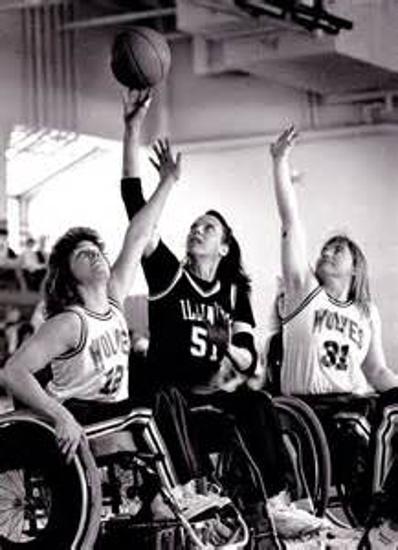
Sharon Hedrick (center), a 1994 inductee in the NWBA Hall of Fame. (photo courtesy of the NWBA)
The Best of The Best – Wheelchair Basketball Hall of Fame
There is a Wheelchair Basketball Hall of Fame, founded in 1973. The NWBA website lists the members and the rules of eligibility—players must compete for a minimum of five years, be a part of an All-American team, and meet other requirements as determined by the voting committee. Non-competitors must give at least 12 years to the sport, as a coach, administrator or supporter.
Among the noteworthy members:
Tim Nugent – Inducted in the inaugural year of the Hall. Nugent was the coach of the first college wheelchair basketball team, the Illinois Gizz Kids, for 12 years. The team won the NWBA championship in 1953. But more importantly, Nugent founded the NWBA and served as its commissioner for 24 years. Today the NWBA has an endowment fund in Nugent’s name.
William Johnson – Also inducted in 1973, Johnson is listed as being the “Best to ever play the game” on the NWBA website. He played for a Long Beach Flying Wheels team that won five straight championships, and he also played for three U.S. Paralympic teams. Johnson later served as the commissioner for the Southern California conference of the NWBA.
Dan DeDeo – Inducted in 1976. DeDeo was one of the first ever certified officials of the NWBA; he officiated in the Eastern Conference (EWBC) for 14 years and later became the EWBC Officials Chairman and the Pacific Coast Commissioner.
Sharon Hedrick – Inducted in 1994, Hedrick was the first woman to be inducted into the NWBA Hall. Hedrick played for the University of Illinois team, winning six MVP awards and seven team championships. She later won medals playing for three U.S. Paralympics teams…the one year she sat out, the U.S. failed to bring a medal home.
Strapping In…
Wheelchair basketball players generally don’t use their own wheelchairs; they play in specialized wheelchairs designed for sports. The sports chairs are made of titanium, don’t fold, and have their wheels angled for more camber and easier mobility.
DeAngelo describes the differences. “Typically, the standard chair, a lot of them are made with titanium, so they’re lightweight, durable. Back in the day when we were first playing there were these old-fashioned spokes that you’d see on a bicycle.
“The biggest difference in the chairs is that less is more. Some people would ride them around in the streets, but you wouldn’t necessarily see that. For my wheelchair, I have these bicycle tires on there for everyday use. For the basketball court they are very thin ones and they would get torn up on the streets.”
They have safety features as well, like the additional small wheels in the rear. “When I first was coming up the biggest thing was that your chair would flip backwards. Someone would hit you in the back of the tire with their foot pedals and your chair would flip right over.
“Now the chairs are made with what we call a fifth wheel or sometimes six wheels on the back of the frame, it’s kind of like training wheels. You still might flip backwards, but it’s not going to be as quick or as pronounced as it would have been.”
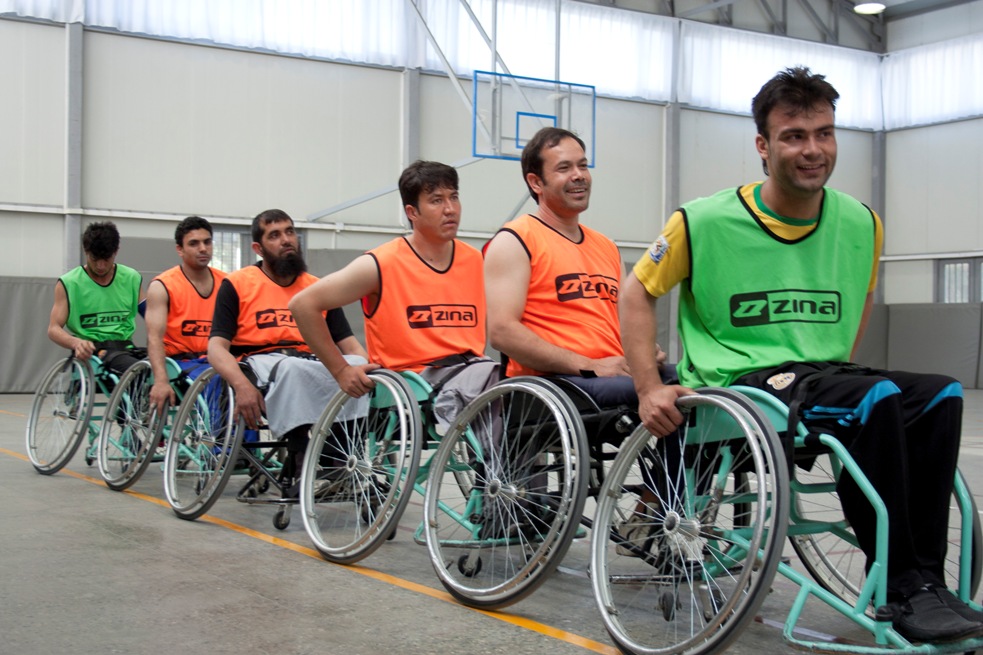
Shapoor Sorkhabi from Maimana (right), the Man of The Match in Afghanistan.
(photo © ICRC / Jessica Barry)
The Thrill of Wheelchair Basketball Victory
Wheelchair basketball has grown quickly in the war torn country of Afghanistan, where a great many civilians have lost limbs to mines and ordnance that are literally everywhere. Recently the International Committee of the Red Cross and U.S. basketball player and trainer Jess Markt began organizing sports programs to help amputees.
The response has been overwhelming…there are hundreds of men and women playing wheelchair basketball now in an organized league.
In June of 2012, after just two years of the program, the ICRC held its first national tournament. It featured teams from four Afghan cities: Mazar-I Sharif, Kabul, Herat, and Maimana. Thanks to the “man of the match”, then eighteen-year-old Shapoor Sorkhabi, the Maimana team triumphed over Herat in the final, 14-4.
After playing for only four years, Afghanistan now has a national team that competed for the first time internationally in May. The ICRC website features profiles of some of the players that competed in Italy, talking about the difference wheelchair basketball has made in their lives.
Says Sorkhabi, “My mother tried to discourage my love of basketball, saying I should put my studies first. But I persisted and started playing four years ago at the physical rehabilitation centre in Maimana.
“I played in a wheelchair basketball tournament and was made ‘man of the match’. After that my mother became proud of me. I was proud of myself, too.”
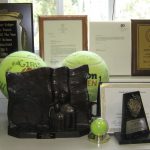
Expanding His Roots – Jeff Holman, Haddonfield High Tennis
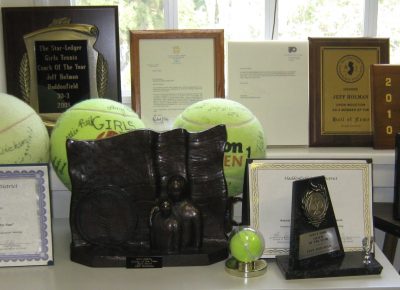
Jeff Holman is a member of the Holman family, a name you’ve heard if you’ve ever shopped for a car in South Jersey. But he’s made his mark coaching high school tennis, with over 2,000 victories to his credit. I interviewed him for the October 2013 issue of JerseyMan. You can view the PDF of this article here.
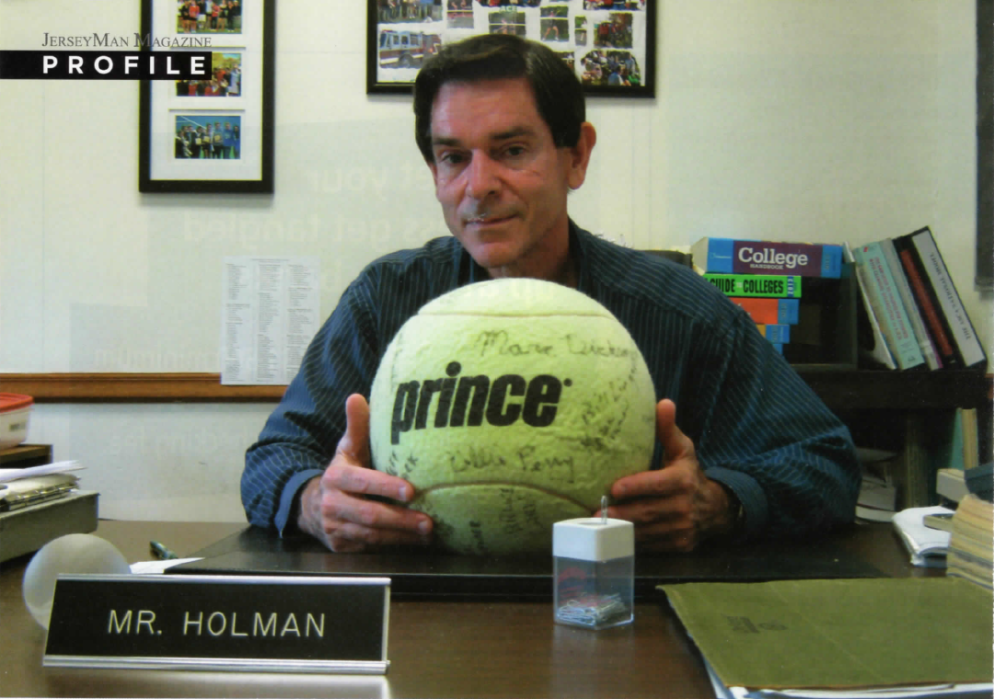
Jeff Holman, the legendary tennis coach at Haddonfield High.
Expanding His Roots
Jeff Holman is a member of the Holman car sales family, but he’s made his own mark in high school tennis coaching.
Mention the name “Holman” to a South Jersey native and chances are a car dealership will come to mind. The name has been selling automobiles in the Garden State for nearly as long as automobiles have existed. Most readers of this publication have probably either bought a car from a Holman or know someone who has.
But over the last three and a half decades, Jeff Holman has achieved what could be called legendary status in a realm that has nothing to do with Cadillacs.
By the time you read this article, Holman, who coaches both girls and boys tennis at Haddonfield High School, will likely have passed an astonishing 2,000 victories—both teams are within striking distance of 1,000 wins each. The boys’ teams have won nine state group championships; the girls’ team has won 18 state group titles and three Tournament of Championship crowns—often against larger schools with bigger talent pools.
He’s gotten quite a bit of recognition himself; 20 Coach of the Year awards, and membership in five Halls of Fame, including Camden County Athletics and the New Jersey High School Hall of Fame, are a small sampling of the countless awards and honors he’s received.
As successful as the family is in car sales, Jeff has proven that the Holmans aren’t a one-trick pony.
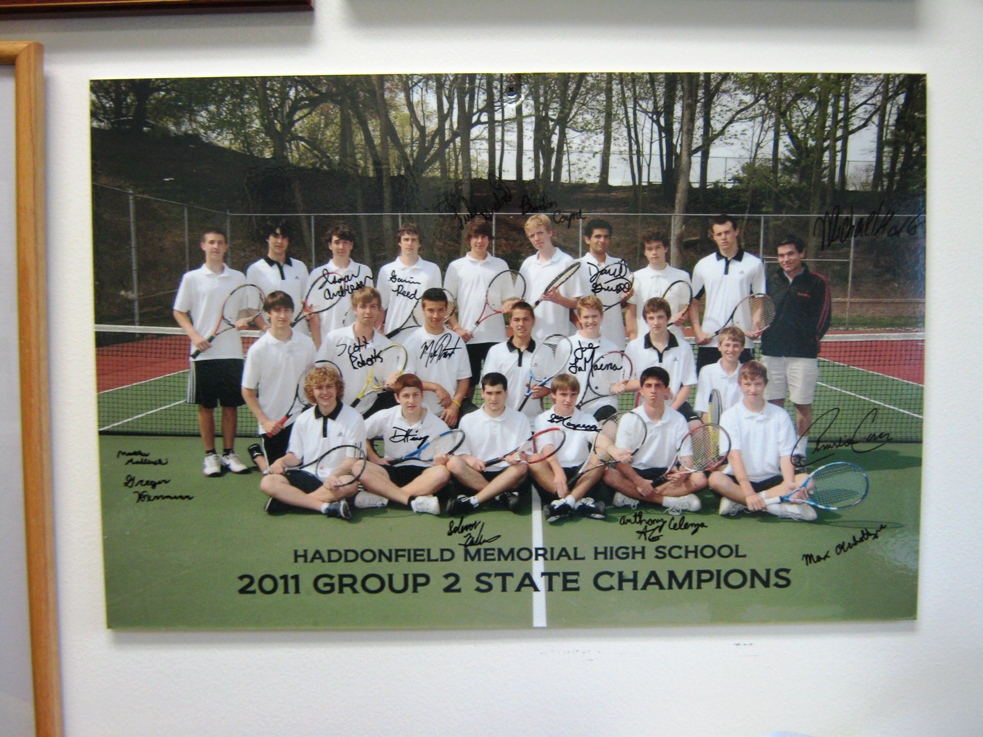
The Group 2 2011 Champions.
As a young lad, Holman probably thought he would sell cars when he grew up. He once wrote a “future career” paper on being a car dealer, which given his background was probably an easy assignment. But he says no undue expectations were placed on him by his Jersey famous family.
“I have two siblings; my sister Mindy is now the CEO of Holman Enterprises, and my brother Steve is a cabinet maker in Dorset, Vermont. Mostly, my parents encouraged me to do what I wanted to do. I had good teachers that encouraged me to get into education.”
Holman was a decent player at Haddonfield High, known for not rushing the net and simply wearing opponents down. But he knew he wasn’t destined for stardom on the court either. He attended college at Princeton, where the talent was, to put it mildly, substantial.
“The #1 varsity player at Princeton (Bill Colson) was ranked ahead of Jimmy Connors. My roommate was a two time Nebraska state champion; he wasn’t even a consistent starter. I was realistic enough, a good high school player, but I never thought I could play professionally.”
After graduating from Princeton, Holman returned to Haddonfield as an English teacher, and served as an assistant coach on the girls’ basketball team. Haddonfield being a small school, there weren’t enough tennis courts for two teams, so the girls’ season was moved to the fall in 1976. Their coach, Ellie Kind, was also the field hockey coach, so Holman took over the tennis team when the two schedules merged.
Two years later, Ken Grabert, the boys’ coach, “decided that driving the bus to events paid more than coaching, which was correct”, and Holman took over the boys’ team. 35 years later, though he’s now a guidance counselor, he is still on the court with young people most afternoons, steadily adding to the impressive win totals and titles.

One of many awards found in Jeff Holman’s office.
Leaders in any endeavor will often tell you that success depends on choosing the right personnel. In high school sports, this presents a significant obstacle. Coaches don’t have the option of recruiting the best players from a 500-mile radius. The kids in town are what they’ve got.
In this environment, Holman magnanimously gives some credit for his success to local tennis clubs as a place where parents teach the game to kids. But he also piled another challenge on top of recruitment limitations: a no-cut rule. Every student who signs up will have a chance to represent Haddonfield tennis. Jeff explains the reasoning:
“One of the best players I ever had was a girl named Phoebe Figland, she was part of the 1980 team that won the first ever Tournament of Champions. Back then we had four courts, I had to keep 16 girls, and Phoebe as a freshman was number 17 so I had to cut her. Luckily she wasn’t one of those kids that gets discouraged easily; she came back and earned a starting varsity position, and went on to become a Division I player at the University of Richmond.
“Maybe in Phoebe’s case it gave her more inspiration to become as good as she did. But I think other people might have quit. Since that time I’ve always looked for a way to keep everyone involved and not cut people.”
That means arranging more matches with more teams, which Holman does. “In our program we have 40-50 players, and schools we play against may have 10-15. So by having a lot of matches and a separate rotation system, even though our team is bigger, all of the players get to play in matches. If they are all involved and can have a fun experience and see improvement, they’ll want to keep on playing and getting better.”
If you’re looking to ferret out a nugget from him about how to successfully coach high school sports, that is mostly what Holman will tell you. Keep all the kids involved, having fun, and playing tough competition. Encouragement and positive reinforcement. Not much about fundamentals.
“The mechanics, a lot of that is learned in the offseason. It’s hard to change someone’s mechanics during the season. They might get worse before they get better. There are outstanding professionals in the area that our students have gone to, and these teachers have instilled some mechanical knowledge of the game.”
So instead of teaching backhands or “getting into the zone”, Holman’s focus is on arranging as many matches as he can with quality opponents, and separating practices into groups so that all of the players get time in with the coach.
He even drives the team bus. It’s a gesture that appears to be a show of humility or bonding, but it is actually rooted in practicality: “If the school doesn’t have to pay a driver, then tennis, which has no transportation costs, enables Haddonfield to play an ambitious schedule. We can go to North Jersey or I can schedule more matches in a week. In this era of budget constraints, not having to play a bus driver really frees up our program.”
Whatever it takes. “I think it’s important to convey that this team is very important to me and I’m going to work harder than anyone else. And that whatever I ask the players to do, I’m going to do the same thing or more in terms of commitment.”
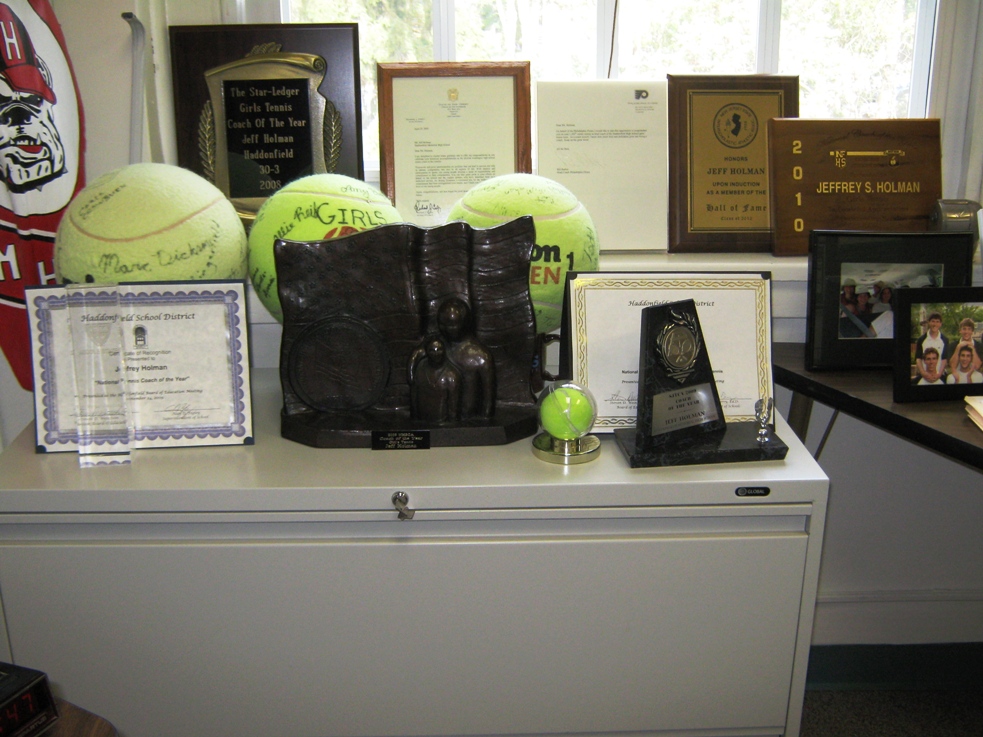
So many awards it almost blocks the window.
Holman’s proudest achievement? After coaching 70-plus seasons, he has trouble picking a favorite memory. “I guess when you do something the first time it stands out. On the girls’ side I think back to a team in 1980, the first year New Jersey held the Tournament of Champions, when the state champions of all the different divisions have a playoff. The 1980 team won that initial tournament. The boys kept falling short in state tournaments; finally in 1983 that group of players was the first Haddonfield team that won a state title.
“Haddonfield has always been a very successful athletic school at everything, but there have only been a couple of teams that have won a Tournament of Champions. The girls’ tennis team has done it three times now. It’s a very rare achievement.”
Holman tempers any appearance of boasting. “It’s nice to win championships, and we’ve done our share of that, but above all we’re trying to instill a love of the sport, and in their later lives they are still playing, and that maybe part of the reason was the Haddonfield program.”
One of the winningest high school sports coaches in the country seems reluctant to suggest that what he does results in more than young people enjoying the game of tennis. But he’s undoubtedly played a role in the character building of many young people. To teach them that they will have a chance to get in the game, to play against the best, and to be able to challenge opponents with unfair advantages and still win, undoubtedly leaves a stamp of confidence on an adolescent mind where self-esteem can often be in short supply.
Especially for a kid that might not have otherwise made a team of 16.
Jeff Holman doesn’t have an apparent personality for car sales. He is a soft spoken, even-keeled fellow, highly regarded by all who know him, but there is still a cauldron of quiet determination in him. If it weren’t for Haddonfield’s reputation as a high school tennis powerhouse, you wouldn’t expect this quiet gentleman to bring a team from a small school that can whip your big school’s behind.
And for several generations of Haddonfield tennis playing alumni, the Holman name means something more than an established place to buy a nice automobile.

The Old Ball Game – SJ Men’s Senior Baseball League
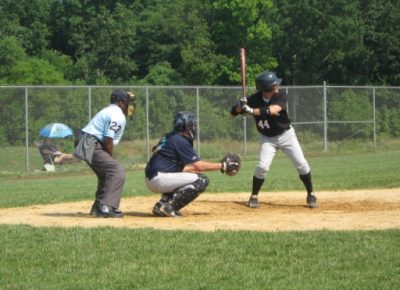
The South Jersey Men’s Senior Baseball League is a haven for men in their advanced years who still can and want to play some baseball. I wrote this piece for the August 2012 issue of JerseyMan; you can view the PDF from the magazine here.
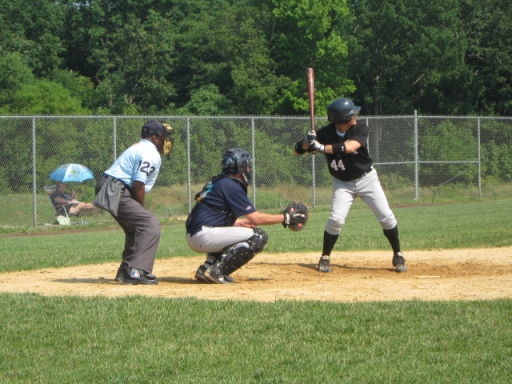
Waiting on the high hard one, adjusting for everything else.
The Old Ball Game
After 20 years, the South Jersey Men’s Senior Baseball League is stronger than ever.
On a picture-perfect Sunday morning at Doc Cramer Field in Manahawkin, the Hammonton Black Sox are playing hooky from church to play baseball, in a time-honored tradition that a Benevolent Supreme Being isn’t likely to mind.
With his team shorthanded, manager Mike Dunleavy must take the field and has enough to keep him busy, so he lets this observer keep score in their game against the Ocean Pirates. At one point a Sox player slaps a weak chop that travels about ten feet but successfully moves the runner on first over to second. There is a dispute over whether it counts as a sacrifice. “You’d be surprised at how much these guys look at their stats,” Dunleavy tells a writer who, as a former softball player, is sure he wouldn’t be surprised at all.
The team has several batters hitting over .400, but they’ve managed little offense in this game. “Junkballers,” the manager says, of his hitters’ performance against the Pirates’ Jeff Martin. “We always have trouble with them.”
In the bottom of the ninth, he calls a conference on the mound with his pitcher Tom King, to figure out how to pitch the Pirates’ Eddie Titley with a runner on second and the game tied. Over King’s objections, Dunleavy orders Titley to be put on intentionally. King, who has pitched a fine game, walks the next two batters, and the Pirates take a 3-2 victory over the Black Sox with two runs in the ninth. Despite its painful obviousness, the manager feels compelled to point it out: “Tough loss.”
Following the game there is a brief shouting match in the dugout between Dunleavy and King over the decision to walk Titley, which is fairly quickly smoothed over. It’s not a contract year, after all.
“From eight to eighty, the game is the same,” Dunleavy says. “It’s still about pitching and defense. There’s nothing I can tell these guys that they don’t already know.”
And so it goes in the senior fast pitch baseball world.
Dunleavy has managed Hammonton’s team in the 45+ American Division for seven years. When his team is shorthanded he will take the field, and occasionally he takes the mound to pitch. At his advanced age, he isn’t stealing bases or hitting bombs or overpowering hitters, but like most pitchers he can still pitch a successful game if he keeps the ball down. The Pirates, he says, are their friendly arch rivals—the Black Sox had lost to them two years before in the championship game, and had beaten them last year for the championship. It’s not Yankees-Red Sox, but it still fires up both teams.
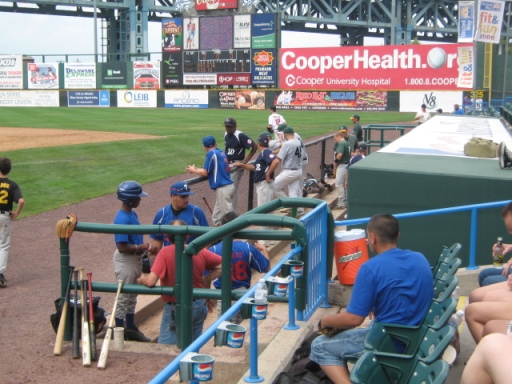
Taking the field in Camden for the All-Star contest.
On July 15 of this year, the South Jersey Men’s Senior Baseball League celebrated its 20th anniversary at Campbell’s Field in Camden. In a brief on-field ceremony, league president Lou Marshall and vice president Neil Hourahan presented league founder Bill Curzie with a plaque, as a thank you for being the indefatigable spark for the SJMSBL and a key ingredient of the glue that has held the league together for 20 years. Whether it is attributable to the league’s success is not certain, but Curzie does not appear to have aged at all in two decades, and at 77 still looks fit enough to play two.
In 1992, at the age of 57, Curzie met up with players of a Pennsylvania division of the MSBL, and asked about setting up a fast pitch baseball league in South Jersey, which had none at the time. National league president Steve Sigler enthusiastically gave Curzie permission, and off he went.
With the help of a story in the Burlington County Times—that began with the words “Curzie is serious”—Curzie spread the word quickly. It turned out that South Jersey was heavily populated with thirty-, forty-, fifty- and even sixty-somethings who still wanted to play ball—and didn’t mind faster pitches or nine innings, the way the game was meant to be played. In less time than it takes a superstar free agent to say “it’s not about the money”, there were enough players for four teams, and the league began with six.
With the help of Curzie’s equally dedicated assistant commissioner Gary Brown, the SJMSBL kept growing, and is now the second largest senior fast pitch league in the nation, with over 1,200 players in four age brackets. There’s been a 25% growth in the 18-year-old group, which bodes well for the long term health of the league. They are adding a 55+ division next season.
Curzie shares the story of his standing firm on the league moving to wooden bats, after the national disgrace of aluminum bats had been the norm for some years in nearly every league. Today, most fast pitch leagues are back to using wooden bats, and Curzie humbly accepts some of the credit for that. When asked the ridiculous question of why wooden bats over aluminum, he has a simple response: “It’s just baseball, man!” He does elaborate further, though. With the reflexes of players at this age, aluminum bats are more dangerous, and besides, there are too many cheap hits with aluminum.
Today Marshall and Hourahan now handle the running of the league. The list of administrative tasks is long. In the beginning of the season, Marshall must be in continuous contact with the national headquarters of the MSBL, ensure that fees are collected, manage schedule changes, work with the umpires’ organization, deal with the inevitable problems that teams will have with the schedule, and arrange the All-Star weekend in Camden.
It’s a lot of work maintaining the league and playing on top of it—a full time job, Marshall admits. It’s all worth it, of course. He echoes the sentiment of the players on the field: “you feel like you’re eight again.”
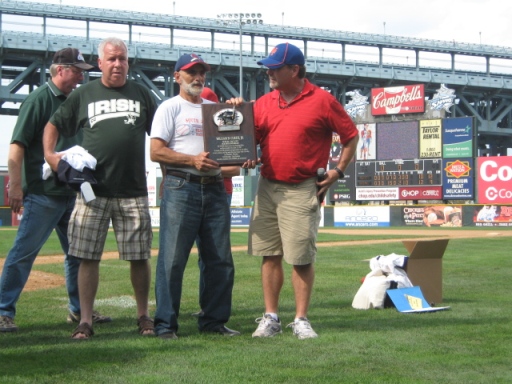
Bill Curzie accepts an award for putting players back on the field again.
There aren’t hot dogs, exploding scoreboards or the roar of the crowds. You won’t see players at the level of Andrew McCutchen or Mark Teixeira here. But you might appreciate, as these fellows do, how difficult it really is to throw out a baserunner attempting to steal or to turn a double play. Dunleavy says, “Hunter Pence can throw out a guy at third base. We would need a couple of extra throws to get the ball there.”
Perhaps, but that’s an exaggeration that doesn’t give credit to the skills many of these fellows have.
They wear uniforms and cleats. They steal bases. They take advantage of fundamental mistakes. They throw the ball around the horn after a strikeout. They use leg braces and pine tar. Balks and infield flies are called. There are rundowns, pickoffs, and lots of spitting. There is pressure to win, real trophies, and real statistics displayed online that people from here to Cambodia can see.
Some players even look for that little bit of rule-bending edge. Marshall tells the story of a pitcher loading a ball with tobacco juice and snot; eventually he even bought a container of K-Y at the store with his wife present—assuring her it was for his “other slider”.
Being an umpire, which pays in the neighborhood of $80 a game, is just as thankless a job as it is at any level of baseball. Players gripe about calls throughout the game, which the ump, who wants to appear professional just as the players do, mostly takes in stride. Between innings an umpire shares stories about rare times where he’s ejected players. One involved a thrown bat making a loud clang; another involved foul language directed at him. But most times, he says, if he’s got to be out in the heat, then so do they.

Stars of the league.
The SJMSBL is a haven for men refusing to age—who desire to compete on the highest level they can, relive the playing days of their youth, and many times to do both.
Anyone can sign up and play. It’s a time commitment; players give up a day of their week, in this case a Sunday morning. They’ll need legs too; they’re going to be running the full 90 feet between the bases. Some of them will get hurt in battle; many of the Black Sox’s best are currently on the DL. During the interview, Marshall—who still plays while running the league—shows me elbow scabs from sliding.
Never once does it occur to any of them that none of the games will be on television, that they won’t be driving a Porsche with their contract, or that it’s highly unlikely anyone besides an insurance company will ask for their signature. They are playing a boy’s game again, and loving every second of it. Who wouldn’t leave it all on the field?
Dunleavy remarks: “I have seen in the faces of the older guys what men’s senior baseball has done for their spirit. They never thought that they would ever get the chance to actually suit up and play competitively again.”
From eight to eighty, the love of the game is the same too.

Let’s Go Racing! – Philly Area Tracks For Racers

You can race some serious go-karts – or even your own car – at several venues in the Philadelphia region. I wrote this piece about them for the Fall 2017 issue of JerseyMan. You can read it on their website here, or you can view the article PDF here. With all respect to a great magazine, I liked my title better…

Speed Raceway go-karts. These karts don’t mess around.
Let’s Go Racing!
“Flat out till you see God, then brake.” – Anonymous
If the closest you’ve come to channeling your inner Jeff Gordon is running a #24 car in a boardwalk go-kart at the shore, it’s time to broaden your horizons. If you don’t need to at least let up on the hammer to get through a turn, it ain’t racing.
Philly-area racing fans not only have two high-end venues a short drive away, both of which feature various experiences for would-be racers, but we also have the option of racing electric karts inside a converted retail store. True.
Boardwalk go-karts might be fun for the kids, but you’d get some strange looks if you suggested it for a team-building event.
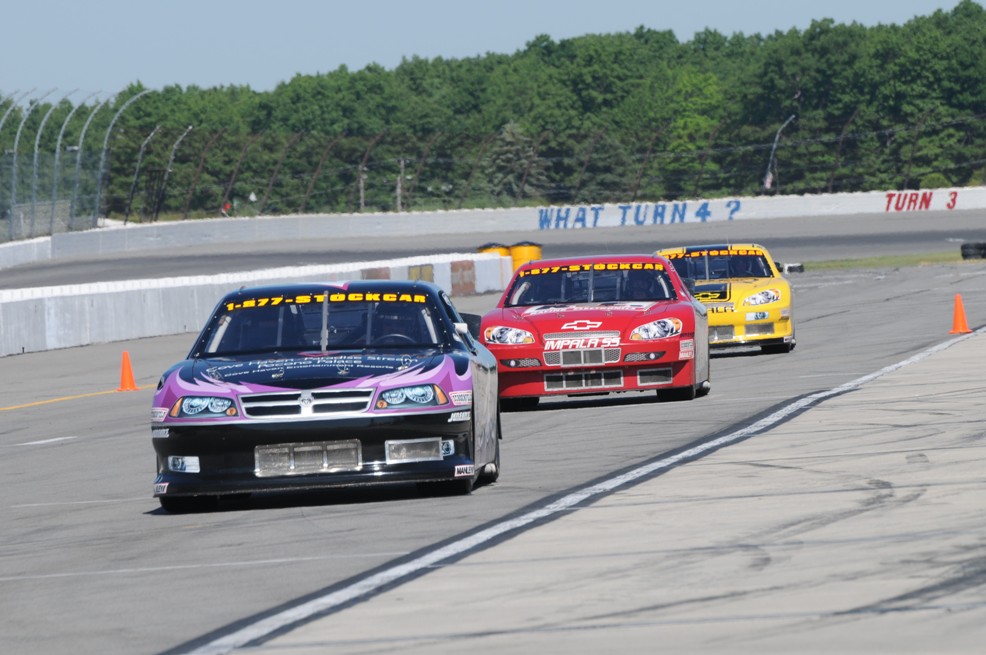
Real stock cars, real racing, at a real NASCAR venue – Pocono Raceway.
(photo courtesy of Jesse Roverana)
Two hours north of our fair city is Pocono Raceway, a track unique enough to have a nickname: The Tricky Triangle. The Triangle hosts NASCAR’s top series twice a year, and its scalene layout boasts the longest straightaway on the circuit. That lengthy stretch would lead to the highest speeds, if drivers didn’t have to stand on the brakes to survive the 14-degree banking in Turn 1.
Courtesy of Jesse Roverana and the crew at Stock Car Racing Experience, you can run the Triangle yourself…either as a student in a 600HP stock car, as part of a team in a go-kart race, or even…get this…in your own car.
The student experience includes an hour of safety instruction before one gets into a firesuit and inside a racecar, driving behind a professional who leads the way to speeds as high as 160 MPH. It’s a life-transforming event, according to Roverana.
“When they walk out to the racecar, their shoulders are down, they’re very meek, very quiet, because they’re a little scared. When they get out, their chest is puffed out, their shoulders are up, they’re smiling. We have them fill out a survey, and their hands are shaking like crazy.”
There’s also a road course for go-karts inside of the famed racetrack, and lawnmower engine karts these are not. They ride an inch off of the ground and go as fast as 50 MPH…helmets required…and races are run with three-man teams for a full three hours. If you’re planning a corporate event, nothing builds team spirit like firesuits and driver changes.
“Every time I sell this to a corporate, they’re calling me back next year because employees want to do it again,” Roverana says. “Smack talk goes on all day long.”
Car guys like to bring their own to race that long straightaway too. “It’s grown tremendously over the last five years. We have a Z06, we have BMW M3s, a whole lot of Mustangs. Every once in a while you get that little Fiat, or a WRX.
“Fortunately, we haven’t had any incidents. They all own a car that is $60K to $160K in value, and none of them want to go home and say, honey, I ran my car into the wall.
“That’s the thing that keeps those guys under control out there.”

Go-karts at New Jersey Motorsports Park. Not a bad idea for a corporate event.
Millville, NJ, isn’t just the birthplace of WAR-demolishing ballplayer Mike Trout. It’s also the home of New Jersey Motorsports Park, where two road courses host events from ARCA to American Superbike to NASCAR’s K&N Series.
Marketing director Ashley Freas calls NJMP the “Premier Motorsports Entertainment Complex”, and it’s not just for spectators. If you get tired of only turning left at Pocono, you can bring your car to the road course here.
“One of the most common questions we get asked is ‘How do I get my car out on the track?’ Challengers, Chargers, I’ve seen all kinds of cars,” Freas says. “I’ve seen Honda Civics, I’ve seen Priuses. There are four on-track sessions throughout the day, and progressively, you build up speed and go faster and faster.”
If you enjoy it enough, you can become a Driver’s Club member…NJMP sets aside track days where only members can pilot their car through the road courses. Members say it’s a great way to entertain clients, and track days include a superb breakfast and lunch at the Finish Line Pub on the grounds. “Drink some water to stay hydrated, but no beer until after you’re done,” Freas says with a laugh.
But for those not yet of such means, the go-karts here are no slouch. They carry 9HP Honda engines and reach speeds of 55 MPH on either of two small road courses that even feature elevation changes. Like at Pocono, karts include transponders, and NJMP tracks your lap times, with the best time of the day written on a board inside the entrance.
Make a day of it, Freas says. “The road courses here always have activity, you can go go-karting but you can also watch unique and fun racing going on. You can eat at the restaurant, we have paintball so you can do that. We have a pool too, if you get hot and sweaty and want to relax.
“It’s like an amusement park. There’s something for everybody.”

Oh hell yeah.
So you are probably thinking, this sounds great, but isn’t this October? Racing season is more or less over. Where can I host the holiday team-building racing event?
The Speed Raceway geniuses are way ahead of you. They saw the opportunities as electric cars emerged at the same time retail stores began to close in the wake of the Amazon explosion.
In the days before the electric go-karts that Speed Raceway uses, it probably would have been too noisy to run gas-powered karts indoors, to say nothing of the collective heart failure that the EPA would have had about the pollution. Electric karts are quiet and don’t cough up smoke, making them ideal to run indoors…which is, as Speed vice president Eric Armstrong points out, a huge advantage for them.
“We’re open seven days a week, 363 days a year. We’re incredibly busy throughout the week and that’s because a day like right now, where it’s raining hard, we’re open. When it’s hot, we’re open, when it’s cold, we’re open.”
And electric karts don’t have to build up to speed, either.
“When you turn on your vacuum, it’s on full power. That’s very similar to our go-karts. They have a lot of torque and they go quick.”
The vice president isn’t exaggerating. When a driver is first let out onto one of the two Formula One style road courses, after donning a head sock and a helmet, the kart moves slowly. Once out on the track, as if someone flipped a switch, stepping on the accelerator suddenly whiplashes the occupant into a focused racer, picking up speed, braking through turns and hitting marks. Speed records lap times, but you won’t reach top speed in MPH terms. Not even Armstrong can tell you what the karts’ top speed is…meaning they’ll go as fast as you can handle.
“If you had an absolute perfect, flat surface, these could easily beat the cars on the highway. But in here, they can’t, because there’s not enough space and you’re turning all the time. You’re always zipping, but you’re never on a flat surface hitting high MPH marks.”
Speed has two locations, in Horsham, PA, and in Cinnaminson, NJ. The Cinnaminson location is located in a large strip mall on Route 130. It’s a marvel of progress for anyone old enough to remember the Clover store that occupied the space for many years.
“With so many retail establishments closing, there’s a lot of big buildings like this, and a go-kart facility like ours really fits,” explains Armstrong. “Five or six years ago, there was maybe ten facilities, now there’s easily 250-plus across the country.
“I guess we can thank Amazon,” he says with a chuckle.
The Speed Raceway experience is thrilling enough to draw occasional celebrities, even from as far as Baltimore. “Joe Flacco and his family come in here quite often. Especially with football players, people don’t recognize them because they wear helmets, until they put their names up on the scoreboard and they say, that is Joe Flacco right there!”

Sounds like a great place for your corporate awards ceremony.
Like the folks at New Jersey Motorsports Park and at Stock Car Racing Experience, Speed Raceway knows exactly how best to promote high speed, edge-of-seat racing for ordinary Joes…as a corporate team-building event, or for a bachelor (or bachelorette) party. At Speed, they’ve even built sound-proof conference centers, so the long-winded manager can spend just enough time thanking the team for the pizza to get cold…but the karts stay ready to run.
The exposure has helped Speed Raceway bring over a million racers through their doors in just over five years.
“It allows groups to blow off steam and do something unique,” Armstrong says.
“There’s really nothing like this as an amusement ride. If you compare it to a roller coaster, you sit in the car of the roller coaster, they strap you down and you hold on. Here, it’s similar, except you’re the one driving. You actually get to control the ride.”
If one of these racetracks starts selling Curley’s fries, they may just make the shore obsolete.
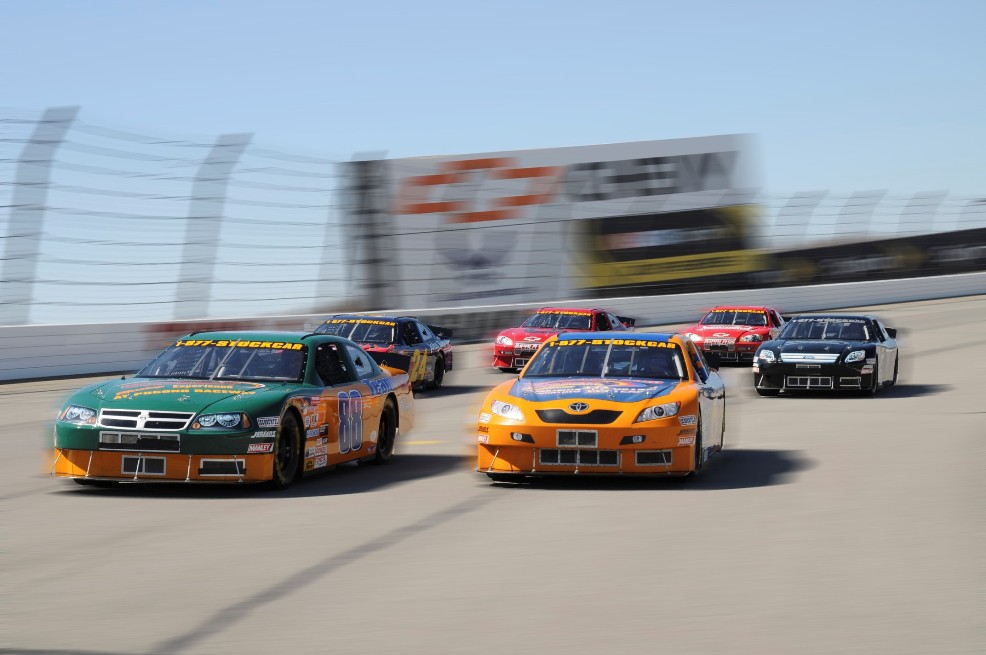
When your Chevy can make the Chevy billboard a blur, you’ve made it. (photo courtesy of Jesse Roverana)
The Mark of Excellence
If you’re a big time car guy and like going fast, you might even be able to lend a hand to the engine guys at General Motors.
As Jesse Roverana says, people bring all sorts of cars to race at Pocono Raceway. And some guys even act as techs for manufacturers. Roverana tells one story:
“We have a guy who’s all about Corvettes. Last summer he bought a new Z06. He brought it up, had problems, at 160 MPH it was shutting down and going into fault mode. He went through a lot of things with GM, and finally about a month ago they wired his car up so that the telemetry was going back to Detroit. He came out for another session, same thing happened, they received the telemetry, they made a change in the tune to the cars.
“I have a feeling that there may end up being a tune coming out that is gonna be mandatory across all 2017 Z06s, because he found the glitch in their system. It was General Motors trying to meet the EPA numbers for that car. They leaned it out a little too much on the tune for 170 MPH,” Roverana says with a chuckle.
“We don’t keep any speed records on the drive your own, I think the fastest that we’ve been told is the gentleman with the Corvette. He’s hit 172. You can go on YouTube and search for ‘drive your own Pocono Raceway’ and you’ll find this guy, Paul Stephens. You’ll find all those videos from the track pack of his Corvette.
“How many people are buying Z06s and going 170 MPH for any period of time? They’re not. But we offered that opportunity.”

Reading The Green – The Woodcrest Country Club

When the Woodcrest Country Club became open to the public, I spoke with Jamie Berman, the marketing director for First Montgomery Group, who had purchased the course. The article was published in the December 2013 issue of JerseyMan. You can view the magazine article PDF here.

The 18th hole of the beautiful Woodcrest Country Club golf course.
Reading the Green
After 84 years as a private club, Woodcrest Country Club is available to the public…and building for the future.
As she shows this observer around the Woodcrest Country Club, Jamie Berman is clearly on top of the ongoing progress.
“We’re looking to make some modifications,” she says, admiring the view of the 18th hole from the shaded patio. “There’s a deck closer to the pro shop, and we’re looking to extend that around to the patio. There’s a versatile outdoor area attached to the club, and a tented patio area for summertime events. We’d like to add a small secondary event area to the ballroom.
“Just looking to make the club more event-friendly and less ‘country club staunchy’,” she says with a smile.
Berman is the marketing director for First Montgomery Group, the real estate outfit that purchased Woodcrest in May for $10.1 million. Shortly after the acquisition, the announcement was made that the private 84-year-old golf course would be made available to the public, with semi-private memberships available.
It’s been an unqualified hit so far: “People have been calling like crazy. We’ve had 35-40 messages come through in just the last few days. We brought on an additional team member just to be a membership director. It’s managed by ownership now, so if we make modifications to the club, we won’t be charging the members.
“The marketplace for golf now is very different than it used to be,” she explains. “The private country club model isn’t as relevant in this economic climate.”
As Berman points out, Woodcrest is being made over for more family-friendly and affordable outings, both on the inside and outside of the clubhouse. There’s still work to be done—like acquiring a proper liquor license—but thus far they have received great reviews from folks that have held events there.
And the golf course itself is no slouch. In the reviews on golf websites, Woodcrest is nearly always rated as “challenging”. That might be an understatement.

Lots of profanity-inducing hills and sand traps here.
The course was designed by William Flynn, which, if you’re an avid golfer, is pretty much all you need to know. If you’re not familiar with the name, Flynn, who lived in the Depression era, was considered one of the greatest golf course architects of his day. Of the 80 courses he designed, five are listed in the Golf Digest list of the 50 best ever.
Flynn’s strength was in designing courses to fit the land they were on, which Woodcrest does, in a location that is hilly for South Jersey. Several holes on the course appear ready to punish a less than ideal tee shot with a rolling hill or a sizable bunker. A recent Courier-Post supplement about the course describes the difficulties of each hole—the tee shot must avoid a stand of white pines on Hole 8, an annoying pine tree just to get within 200 yards on Hole 14, or a sunken fairway and trees on Hole 16. If you’ve given up profanity for Lent, you might want to skip a round at Woodcrest until Easter.
“Flynn had a mantra that every hole should develop its own problem,” says Bill Torlucci, the Woodcrest golf director. “He really gave players something to deal with on every hole. The green design, the size of the greens, it’s a lot of elevation for South Jersey. Tree-lined fairways, well-bunkered, fast greens, combine all that and it makes for a very challenging course. If you shoot par or better here, you’ve played a really good round of golf.
“I’ve been able to do it a few times, not as much as I’d like to.”
Berman adds, “This course has been private for almost a century, so some people were finding it really difficult, because it has intricacies that private clubs have that public ones don’t necessarily. We don’t want to disrupt the challenges, but we want people to come back!” she laughs.
“But everyone thinks it’s beautiful. They’re always amazed at the beauty. We have slopes that are more defined, split greens; the bunkers are so well done they look like they’ve always been there. We were lucky; Performance Golf Management maintained the course impeccably through the bankruptcy proceedings. We were able to open it right back up in June.”
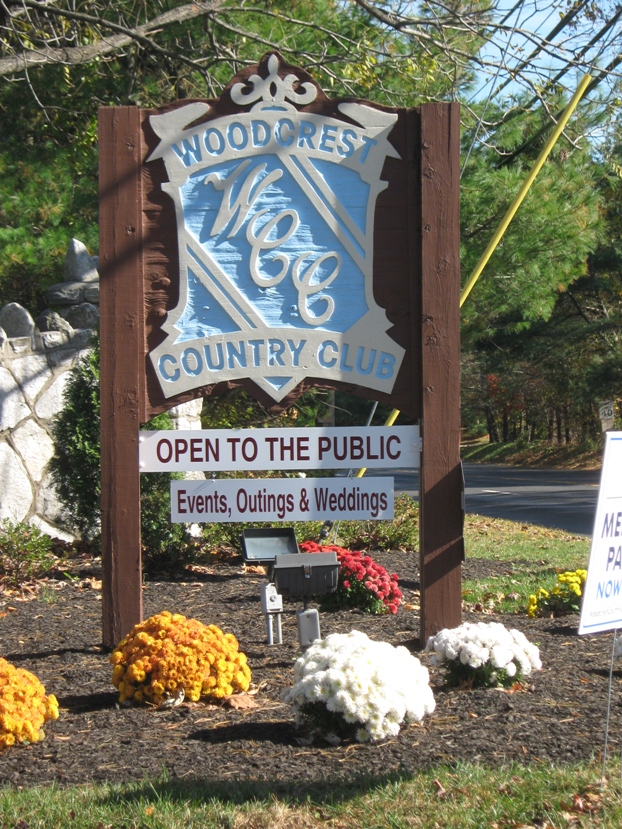
With the helpfully informative “Open To The Public” added.
Even with the enthusiasm of the new owners, First Montgomery’s acquisition of the course hasn’t been without controversy.
In October, news stories hit about the possibility of a housing development being built on the land, which included low-income housing mandated by the Cherry Hill government. It being election time, local politicians made sure they were quoted heroically taking on the big, bad real estate developer. To read the quotes, one would have thought First Montgomery’s only purpose in buying the land was to demolish a beloved, historic golf course and build a new Pottersville.
Berman, who admits to some frustration at the news reports, offers her opinion on the media firestorm. “It doesn’t look like we’re closing the club, does it?” she asks.
“I know it’s election time and there’s a lot of emotion surrounding this golf course, and I know there’s an issue in Cherry Hill with keeping open space. When they were initially looking at this land, it was always the intention to keep it an 18-hole golf course. There are two extra holes, so there is an opportunity to develop a piece of it and still maintain the golf course the way it is. I think when people hear housing and development, it has a lot of charge to it.
“I’m not gonna step over the fact that we are real estate developers; our main business has been the multi-family housing industry. I’m sure it’s an easy connection to make. But we are diversified, and like to look at purchasing aspects to enhance what we can do in a community. The owners are people with a 30-year untarnished reputation. There’s such an appreciation for these men, they’re good people and they give back a lot.”

Jamie Berman, in the newly revamped country club.
So if Berman is to be believed—and she certainly comes off more believable than any grandstanding politician you’ve ever met—this classic, William Flynn course will remain intact. And golfers no longer need to befriend a member to play a round on one of the most picturesque and challenging golf courses in South Jersey.
In addition to making a superb golf outing available to everyone, First Montgomery’s focus is to make Woodcrest more family-friendly. Perhaps even with outdoor fire pits, for events any time of year, Berman muses. Politics aside, both Berman and Torlucci think the future looks bright for this old relic of a country club.
“I’m pleased with the hard work that the startup team put in. We’re booking weddings for 2015 already,” Berman says. “I’m just so proud that we’ve hit the ground running, and we haven’t skipped a beat regardless of what’s going on in the media. We’ve stayed the course, so to speak,” she says with a grin.
Torlucci adds, “There was a mystique about being able to play here. It was pretty restricted, now it’s semi-private. It’s really rewarding for me to be here and see so many people come through that door and that they enjoy it.
“It’s a special facility, it really is.”
And today a golfer doesn’t need friends in high places to see for himself.

Sons of Philly – The Philadelphia Union
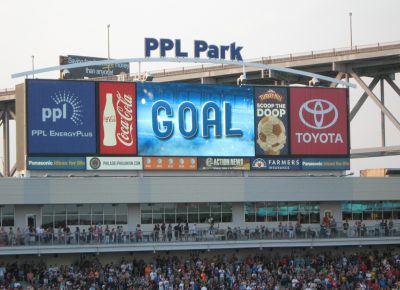
When the Philadelphia Union were a relatively new Major League Soccer team, JerseyMan sent me to interview their then-CEO Nick Sakiewicz. I took some time to talk with members of their fan club too. Fun piece to write, and they gave me tickets and press passes! This article was featured in the August 2014 issue of JerseyMan. You can view the PDF of the magazine article here.

The Sons of Ben, at the River End of then-PPL Park.
Sons of Philly
In their fifth season, the Philadelphia Union have an established fan base, a fan club as dedicated as any in sports, a beautiful venue, and what appears to be a very bright future.
From the moment of the opening kickoff, the chanting begins.
A couple of thousand fans, in the aptly named River End section of PPL Park, are shouting and singing, with drums pounding continuously. Their energetic intonations change themes frequently, but they continue almost nonstop throughout the evening.
Their enthusiasm is palpable, giving the impression that the River End is unquestionably the place to be to enjoy a soccer match. The rest of the 18,000 here tonight are almost subdued by comparison, as if they are witnessing an entirely different event.
This isn’t to say the other fans are apathetic, of course…it is Philadelphia after all, and any sports team that performs well will be warmly received, as the Union players are when they launch three goals in the Colorado Rapids net.
But for anyone present at a Philadelphia Union game, it’s clear that it takes a special kind of fan to sit at the River End with the Sons of Ben.

A capacity crowd at the Union match.
Despite a disappointing first half of the 2014 campaign, the Union are playing to 98% capacity crowds in their shiny new venue.
PPL Park, located in Chester, is an open-air facility designed exclusively for soccer. It is neatly planted along the Delaware River waterfront, with many of the seats affording a striking view of the Commodore Barry Bridge. With 18,500 seats, it’s large enough to feel major league, yet small enough that no seat is too far removed from the action. Fans in the furthest seats can admire the professional footwork of the players.
Philadelphia was near the top of the list of cities targeted for teams when Major League Soccer was founded in 1993. But the insufficient venue became a problem. Veterans Stadium, home of the ill-fated Atoms and Fury teams of the 1970s, caused MLS to look elsewhere at the time.
Current Union CEO Nick Sakiewicz, who was in on the founding meetings, tells the story:
“It was in an office in L.A., we had a whiteboard, and we were deciding which cities we were going to put teams in. Philly was in the top five. We’re starting a league, where do you need to be? L.A., New York, Philly, Chicago, Boston.
“The reason Philly never made it to the original ten was because of Veterans Stadium. It was a poor stadium, headed toward the wrecking ball, the Linc wasn’t coming anytime soon, and we had to start the league in 1996.
“We couldn’t come to a good solution where we felt the team would be hugely successful out of the gate, so we ended up going to D.C.
“The Metro Stars team that I managed, we played in Giants Stadium, 86,000 seats, we averaged 20,000 a game. Not even half full, lousy field, American football stripes, fans would come and say, ‘this isn’t serious.’”
So one of the nation’s biggest markets was not represented until MLS became popular enough to expand…into cities like Toronto, San Jose, Houston, and finally, Seattle and Philadelphia.
Once MLS began to expand, just in case they needed any encouragement to come to Philly, the Sons of Ben were there to help.

You know you’re a fan when you haul a big-ass bass drum to a match.
The Sons of Ben were founded by Bryan James and Andrew Dillon in 2007, solely for the purpose of bringing a major league soccer team to Philadelphia. They are named for Ben Franklin, arguably history’s most notable Philadelphian. As member Tim Sosar accurately puts it, “He helped found a nation, just as we helped found a soccer club.”
In a few short months, two tireless guys became over 650 fans toiling for the love of soccer and a city. They lobbied MLS for a team and local politicians for a venue. Scarves, flags and shirts bearing logos were designed, petitions attracted thousands of signatures, and pledges of season ticket sales were sent.
But the SoBs’ most notable statement came in their bus trips to matches in New York and D.C., where they sometimes numbered in the hundreds—and made their presence known as only Philly fans can.
Along with repeated chants of “Philadelphia!”, in New York they bleated at the Metro Stars: “We’ve won as many cups as you!” In D.C. for an MLS Cup Final, the SoBs bellowed “Buffalo Bills!” while sitting among fans of the frequent bridesmaid New England Revolution…a jeer that resulted in projectiles being thrown at them by enraged Revolution fans.
New England lost the match. Philadelphia won a soccer team.
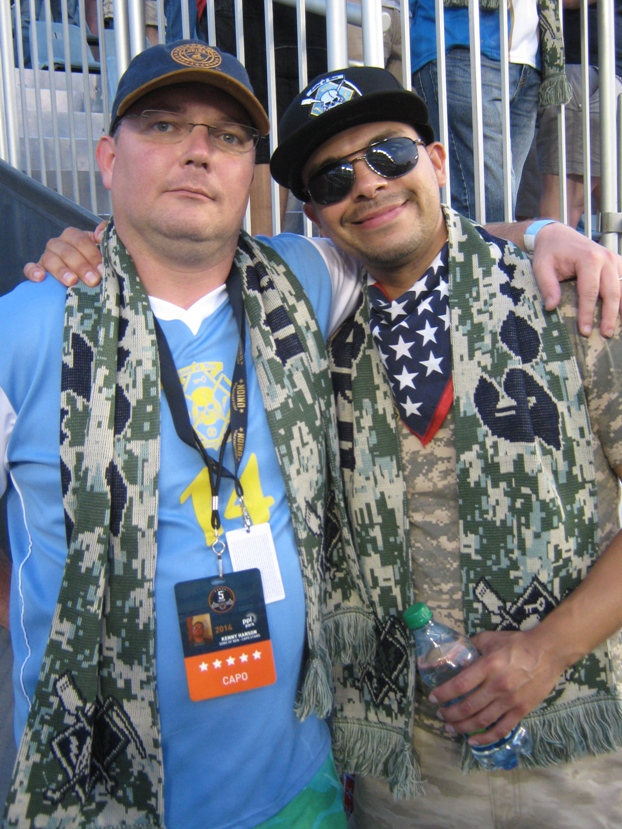
Kenny Hanson (left), the then-president of the Sons of Ben.
Kenny Hanson, current president of the Sons of Ben, is unequivocal. “The Union is here because of the Sons of Ben. Otherwise there would not be a team here.” Sakiewicz doesn’t disagree, calling their contribution “massive”.
“They were influential in our logo design, their colors, the snake that’s in our logo is from that focus group. And how the culture emerged. The DNA of the Sons of Ben is in the DNA of the Union.”
Indeed, Sakiewicz—a proud, dues-paying member himself—was so impressed with the fervor of the SoBs that he offered to buy them a beer for their effort when the team’s arrival was announced. It cost a bit more than he expected.
“I wasn’t sure how big the group was yet, because all of this was on the Internet. Is this three guys in a garage, is it 50 guys, or is it 100 guys? So I said screw it, what’s 50 or 100 beers? When I rolled up there were 800 people. Big American Express card bill.
“Worth every nickel. Best $6,000 I’ve spent.”

Be sure to say it with fifty “O”s.
Half a decade later, the Sons of Ben are now over 5,000 strong, and with the near sellouts at PPL Park, it would be hard for Philadelphia area natives to argue that American soccer…finally…is picking up steam.
Sakiewicz credits social media and generational bonding for the surge. And the USA’s performance in the World Cup helped.
“We used to have books to go to, the Millennials have this (holding smartphone). On this you can follow every league in the world, every player in the world.
“Did you see the heat map of Twitter? When Christiano Ronaldo scored the second goal for Portugal, which pretty much iced it for us, Twitter did this heat map, the whole country just lit up red. Great graphic on ESPN.
“On top of this, millions of them have been playing the game the last 30 years. The 80s kids are Sons of Ben members, and they aren’t kids anymore. They’re money making, money spending professionals who are having kids. The pipeline of soccer fans is beginning to age and come through generationally. Add into that foreign expats…big Spanish speaking foreign expats. Guess what their parents played and loved? Soccer.
“So now it’s an American sport. In Brazil right now, the largest percentage of tourists are Americans. Nearly 200,000. Biggest single nation that is visiting Brazil for the World Cup.”
Sakiewicz and the Union don’t plan to rest on their considerable success at the gate. PPL Park was built to expand, and they will when the time is right, he says. But the first matter on the front office minds is turning the Union into a title contender, starting with finding a team manager.
“I’m sitting on over 200 resumes from around the world,” Sakiewicz notes. “There are some big names interested in coaching this team. Which is frankly very surprising to me, and maybe it shouldn’t be. With the exposure the league’s getting, games are more prevalent in Europe and South America. They see the quality of the league, what’s going on, the World Cup with America doing so well.
“Anyone who’s been in this for 30 years, like I have, shouldn’t be saying, ‘Well, how did we get so good?’ 20 years of MLS, brick by brick by brick. And bang, all of a sudden Tim Howard’s on Good Morning America.”
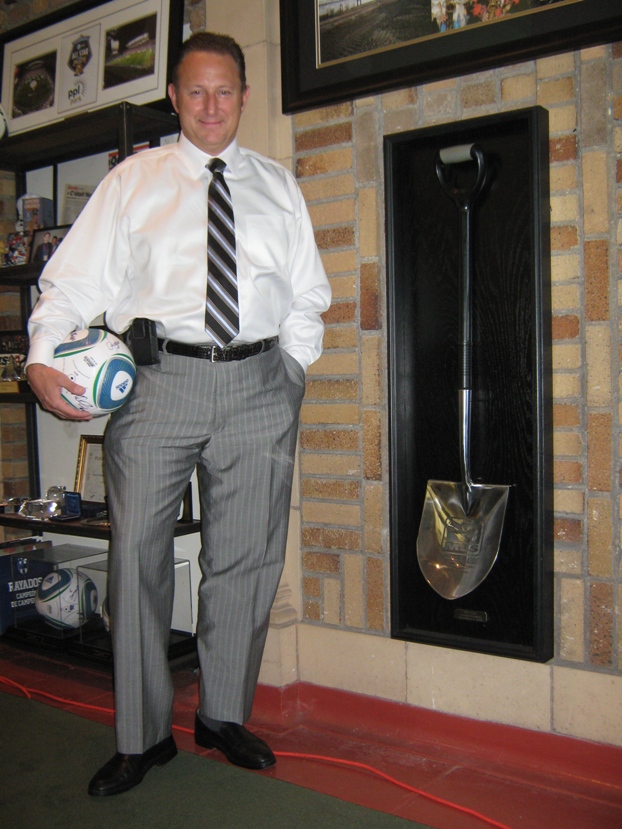
Nick Sakiewicz, the proud CEO of the Philadelphia Union, in 2014.
A native of Passaic, Sakiewicz is most proud of those around him who have been a part of this thriving sports enterprise in the City of Brotherly Love.
“If all of this went away, and I was down to my American Express card and me, give me the same people and we’ll do it all over again. I’ve managed three other clubs, launched the league with the founding executives, and that was all fun. But what this project has been about is much more near and dear to my heart, because first of all I own a piece of it, which helps. But also, I fell in love with this area and the city of Philadelphia and the people.”
Sakiewicz adds an apparent contradiction that he is confident every Philly fan will understand.
“It’s a hard place, but it’s also a soft place.”
“It’s a passionate place. I’m not throwing stones at New York, but I get it now. I’m a Philadelphia guy. It’s a really great place to operate—if you know how to be a Philadelphian.”
A skill that anyone can learn, should they need help, from the Sons of Ben.
Note from Kurt: Kenny Hanson, the president of the Sons of Ben at the time of this article, sadly passed away in 2017. You can read this article about the reaction to the tragedy. It was a great pleasure to meet with Kenny and speak with him. He was a funny guy. R.I.P. Kenny.

